Honduras is an incredibly diverse and beautiful country, home to a variety of fascinating birds. With more than 700 species of birds, Honduras is a paradise for birdwatchers, offering a wide variety of habitats to explore and a rich selection of birds to observe.
From the vibrant and colorful tropical species to the shy and elusive forest dwellers, Honduras has something to offer every bird enthusiast. We will take a closer look at some of the most interesting and unique birds that call Honduras home.
1. Scarlet Macaw
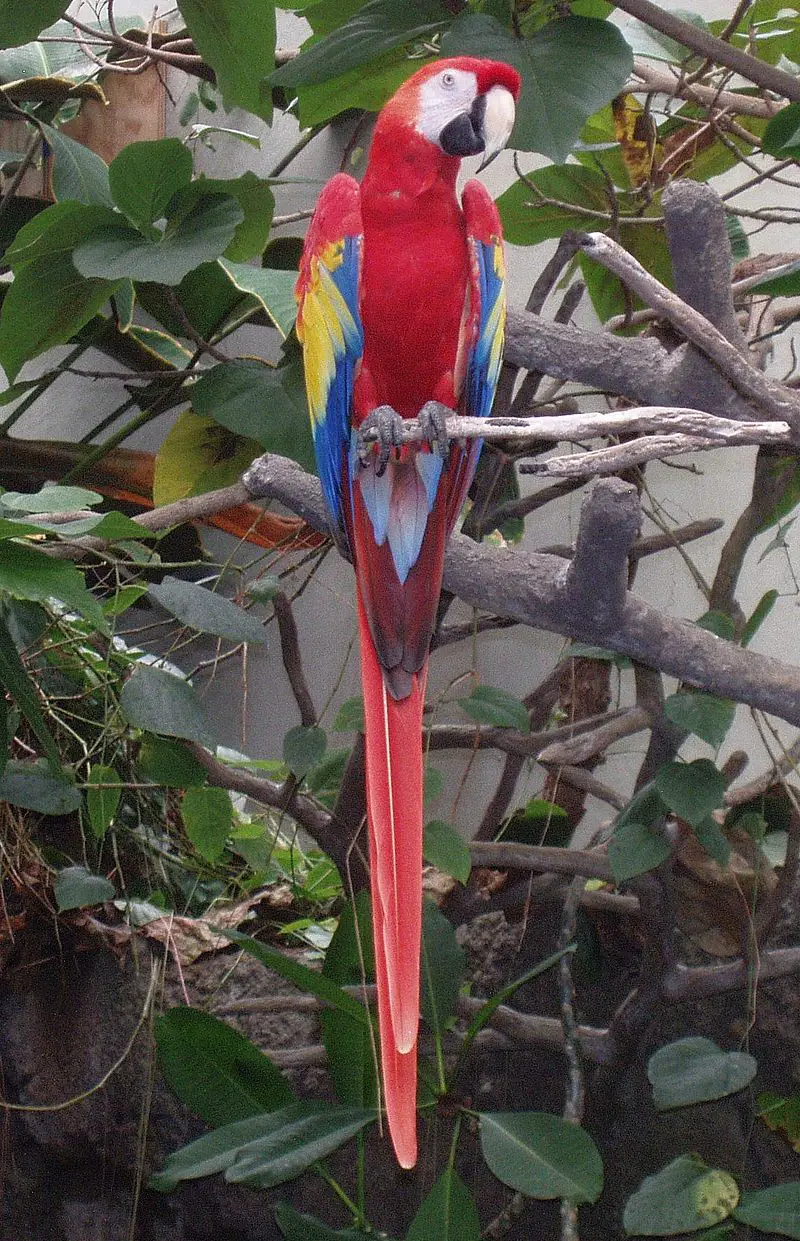
The Scarlet Macaw is a vibrant and beautiful bird found in Central and South America. Its striking red, yellow, and blue feathers make it stand out among other parrots.
It inhabits humid evergreen forests of the Neotropics from Mexico to Peru, Ecuador, Colombia, Bolivia Venezuela Brazil up to an altitude of 1000m (3300ft).
These birds have strong beaks which they use for breaking open hard nuts or seeds that would otherwise remain inaccessible.
They also form social bonds with their mates by grooming eachothers’ feathers and engaging in playful activities such as chasing one another around tree trunks.
Despite its vivid colors the Scarlet Macaw remains vulnerable due to habitat loss caused by deforestation so conservation efforts are essential if this amazing species is going to survive for future generations.
Scientific classification:
| Kingdom | Animalia |
| Phylum | Chordata |
| Class | Aves |
| Order | Psittaciformes |
| Family | Psittacidae |
| Genus | Ara |
| Species | A. macao |
2. Honduran Emerald
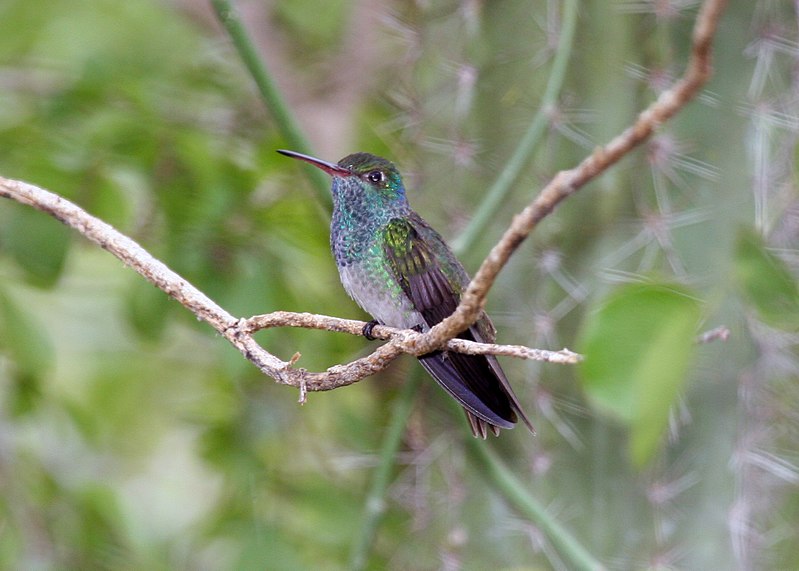
The Honduran emerald is a beautiful and Vulnerable species of hummingbird that belongs to the ‘emeralds’ tribe, Trochilini.
It has been endemic to Honduras since its formal description in 1868 by American ornithologist George Newbold Lawrence from a specimen collected there.
The bird features iridescent green feathers on top with metallic blue-green underside colouring for males, while females have mostly dull coloured plumage.
Its elongated tail consists of two outer rectrices which are notched or slightly pointed at ends along with black tips and white bases.
This small but beautiful bird feeds mainly on nectar from flowers as well as small insects like spiders, flies etc., making it an important pollinator for various species of plants in Central America’s tropical forests.
Scientific classification:
| Kingdom | Animalia |
| Phylum | Chordata |
| Class | Aves |
| Order | Apodiformes |
| Family | Trochilidae |
| Genus | Amazilia |
| Species | A. luciae |
3. Toucans
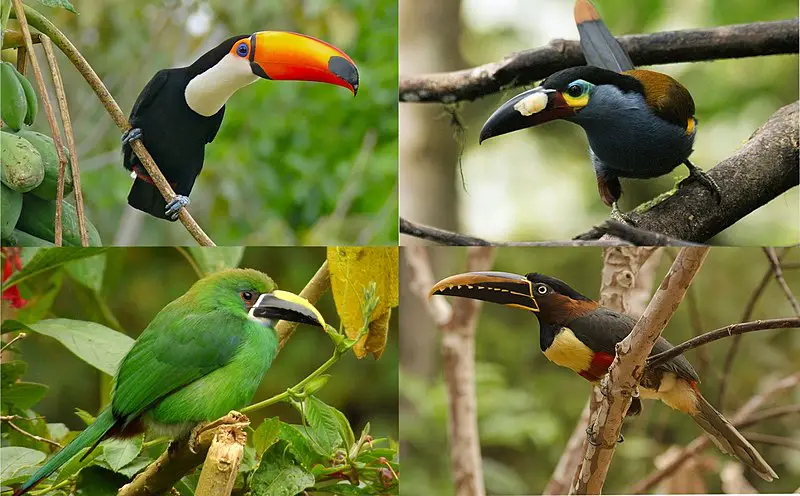
Toucans are members of the Ramphastidae family, which is closely related to American barbets. These birds have brightly-colored feathers and large beaks that come in a variety of colors.
They tend to live high up in trees, where they make their nests with two or four white eggs inside.
Toucans typically feed on fruits and sometimes small insects as well. Some species can even catch larger animals such as reptiles and amphibians for food.
Although toucans like to keep close together when living in groups, during breeding season they become more aggressive towards each other due to competition over resources like nesting sites or food sources.
Scientific classification:
| Kingdom | Animalia |
| Phylum | Chordata |
| Class | Aves |
| Order | Piciformes |
| Infraorder | Ramphastides |
| Family | Ramphastidae Vigors, 1825 |
4. Trogon
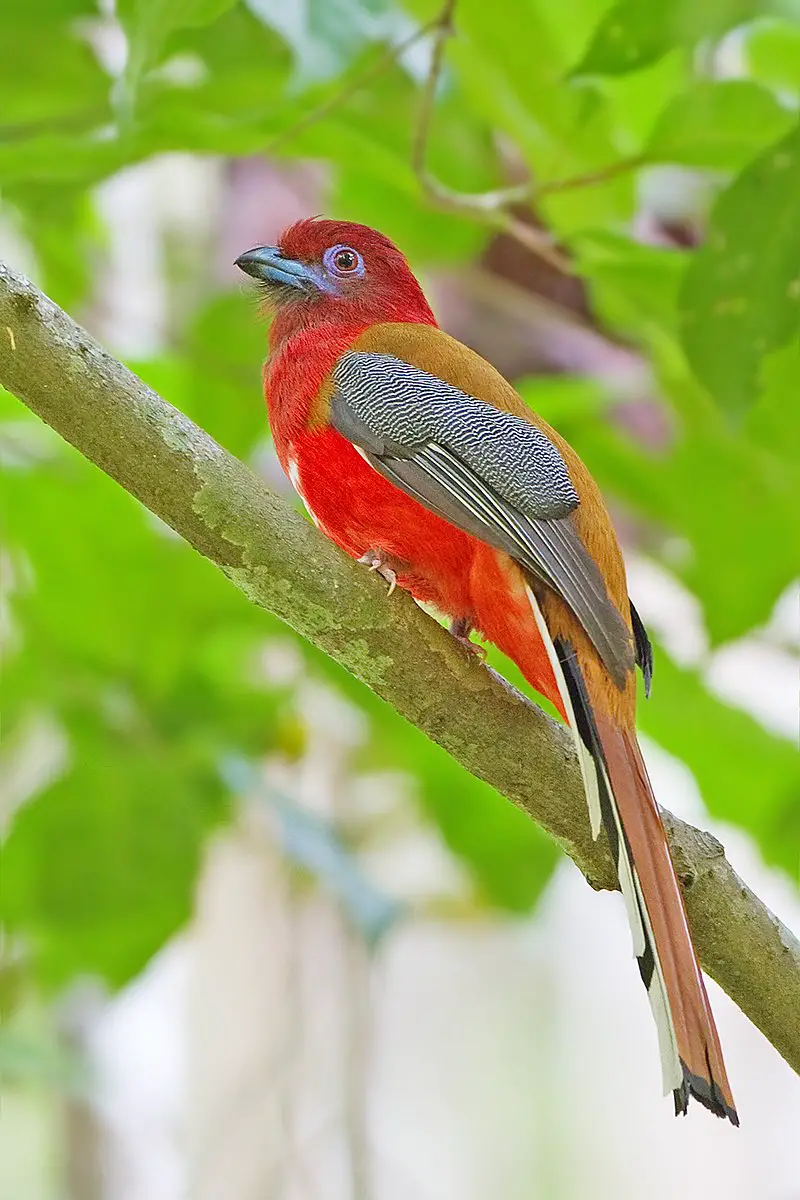
Trogons are a unique bird species that can be found all over the world. They belong to the order Trogoniformes and have only one family, called Trogonidae, which consists of 46 species in seven genera.
Fossil records show that trogons existed 49 million years ago during the Early Eocene period. It is believed they may be closely related or form part of two other orders: Coraciiformes and Passerines.
These birds typically have brightly colored feathers with some having iridescent colors on their wings and tails as well as red bellies and breasts.
Their diet mainly consists of fruit, insects, lizards and frogs but larger ones will also feed on small mammals such as mice or bats.
The most famous member from this group is Quetzalcoatlus – an extinct giant pterosaur which lived approximately 70-65 million years ago.
Scientific classification:
| Kingdom | Animalia |
| Phylum | Chordata |
| Class | Aves |
| Clade | Cavitaves |
| Clade | Eucavitaves |
| Order | Trogoniformes AOU, 1886 |
| Family | Trogonidae Lesson, 1828 |
5. Wine-Throated Hummingbird
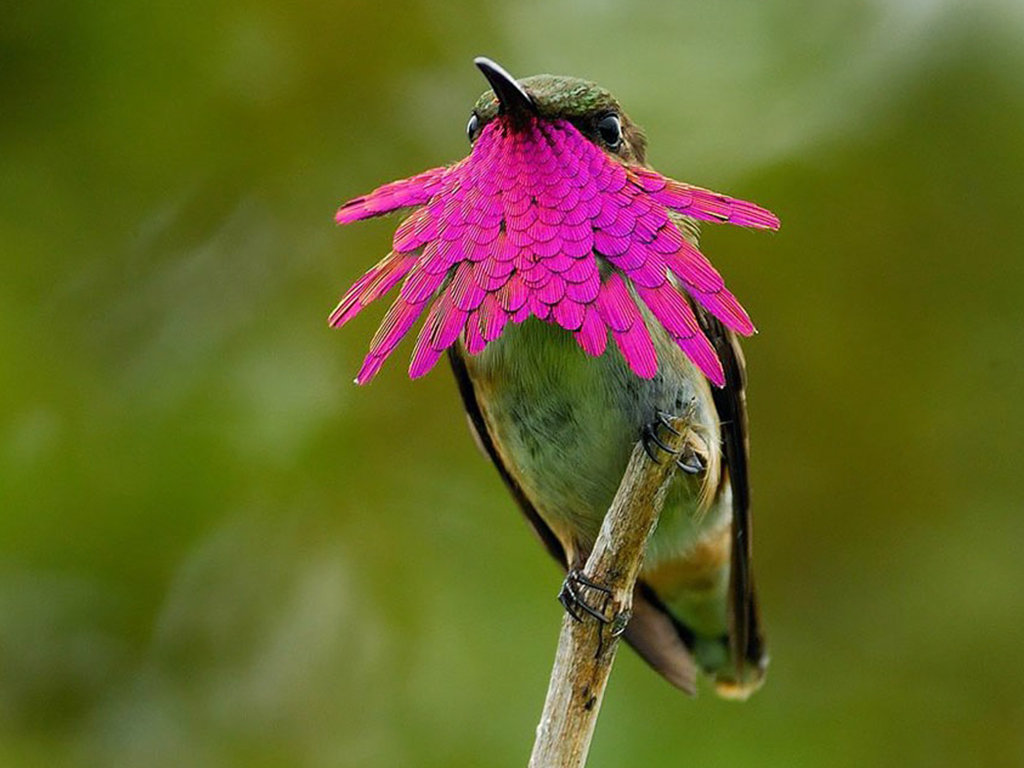
The Wine-throated Hummingbird is a species of hummingbird found in El Salvador, Guatemala, Honduras and Mexico. It belongs to the tribe Mellisugini in subfamily Trochilinae.
Its feathers are vibrant shades of green with an iridescent red throat patch that gives it its name; males also have some purple on their crowns and sides.
They feed mainly on nectar from flowers but occasionally eat small insects for protein.
These tiny birds measure just 7 cm long and weigh only 3 grams.
Their wings beat up to 80 times per second allowing them to move rapidly between flowers when looking for food or defending territory against rivals. A truly remarkable sight indeed.
Scientific classification:
| Kingdom | Animalia |
| Phylum | Chordata |
| Class | Aves |
| Order | Apodiformes |
| Family | Trochilidae |
| Genus | Selasphorus |
| Species | S. ellioti |
6. Resplendent Quetzal
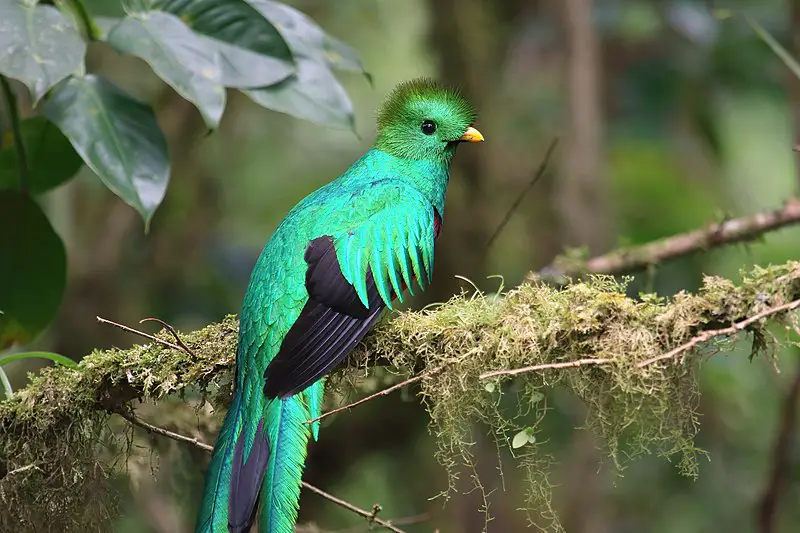
The resplendent quetzal is a beautiful and vibrant bird found in Central America. It belongs to the family Trogonidae, which includes birds like trogons and motmots.
This species of quetzal has two recognized subspecies: P. mocinno and P. costaricensis, both living in tropical forests such as montane cloud forests.
They are omnivores, typically eating fruits from various plants along with insects, lizards or eggs when available.
The male’s plumage is particularly striking with its multi-colored feathers ranging from green to blue to red that gives it its namesake “resplendence” look.
This coloration comes at a price for males because their bright colors make them more visible predators than females who have duller brown coloring instead.
Regardless of gender though all members of this species demonstrate great agility in flight due to their long tails which help stabilize them even through tight turns.
Scientific classification:
| Kingdom | Animalia |
| Phylum | Chordata |
| Class | Aves |
| Order | Trogoniformes |
| Family | Trogonidae |
| Genus | Pharomachrus |
| Species | P. mocinno |
7. Ocellated Quail
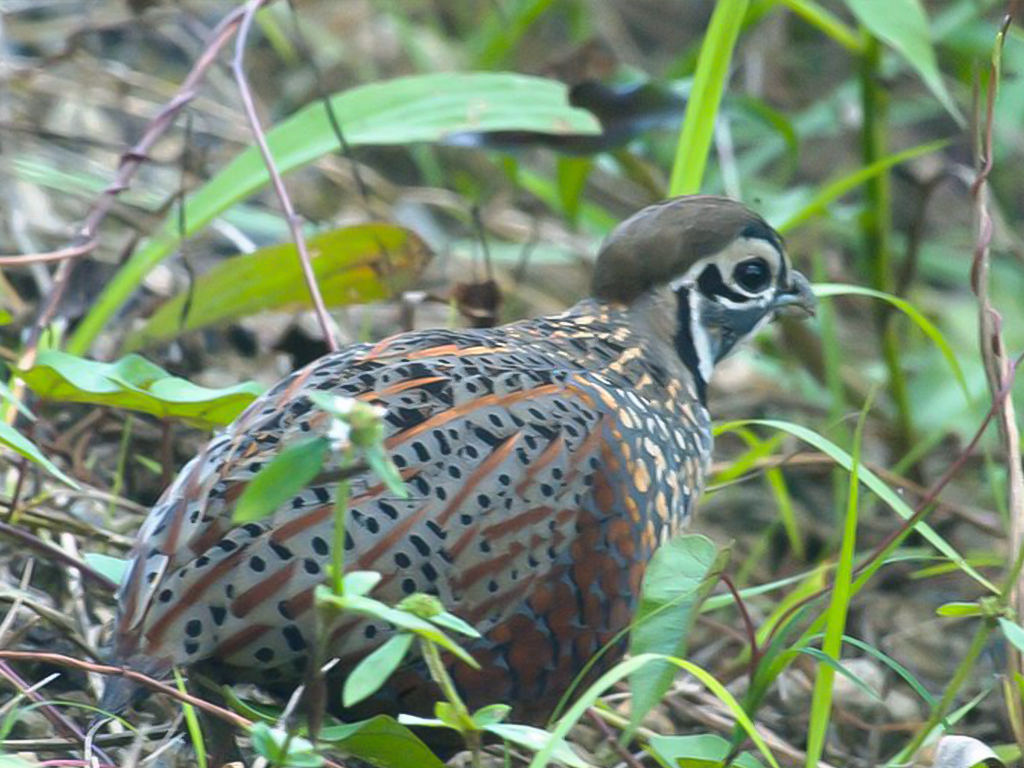
The Ocellated Quail is a medium-sized bird belonging to the family Odontophoridae. It can be found in Central America, including El Salvador, Guatemala, Honduras, Mexico and Nicaragua – but it’s the only species of its genus Cyrtonyx.
Males measure around 20.5-23cm long and weigh an estimated 218g while females are slightly smaller at 18-20 cm and 200g respectively.
This quail has distinctive features that set it apart from other birds; most notably its large black eye spot on either side of their heads surrounded by pale blue feathers which gives them their name ocellatus (meaning ‘eye spotted’).
They also have reddish brown upperparts with buff underparts making them stand out even more. Their diet consists mainly of seeds as well as insects such as grasshoppers or beetles when available.
With this unique combination of looks and behaviours they make for very interesting avian companions.
Scientific classification:
| Kingdom | Animalia |
| Phylum | Chordata |
| Class | Aves |
| Order | Galliformes |
| Family | Odontophoridae |
| Genus | Cyrtonyx |
| Species | C. ocellatus |
8. American Pygmy Kingfisher
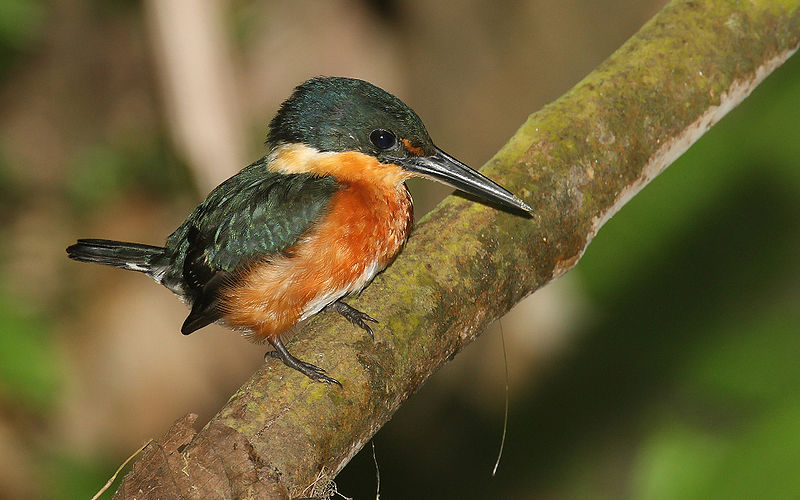
The American pygmy kingfisher is a species of water bird belonging to the subfamily Cerylinae and family Alcedinidae.
This small, colourful kingfisher can be found in tropical regions from Mexico southwards through Central America and into every mainland country in South America excluding Chile and Uruguay.
It also occurs on Trinidad Island. The first formal description of this beautiful creature was made by German naturalist Johann Baptist von Spix as part of his Avium Species Novae series published back in 1824.
Its scientific name Chloroceryle aenea refers to its bronze-green upperparts which contrast with its white undersides – Aeneas being an Ancient Greek term for ‘bronze’ or ‘copper’.
They are usually solitary birds living near bodies of freshwater where they feed mainly on fish, crustaceans, insects and their larvae.
Scientific classification:
| Kingdom | Animalia |
| Phylum | Chordata |
| Class | Aves |
| Order | Coraciiformes |
| Family | Alcedinidae |
| Subfamily | Cerylinae |
| Genus | Chloroceryle |
| Species | C. aenea |
Also Featured In: Birds that Live in Tabasco,
9. Yellow-Naped Amazon
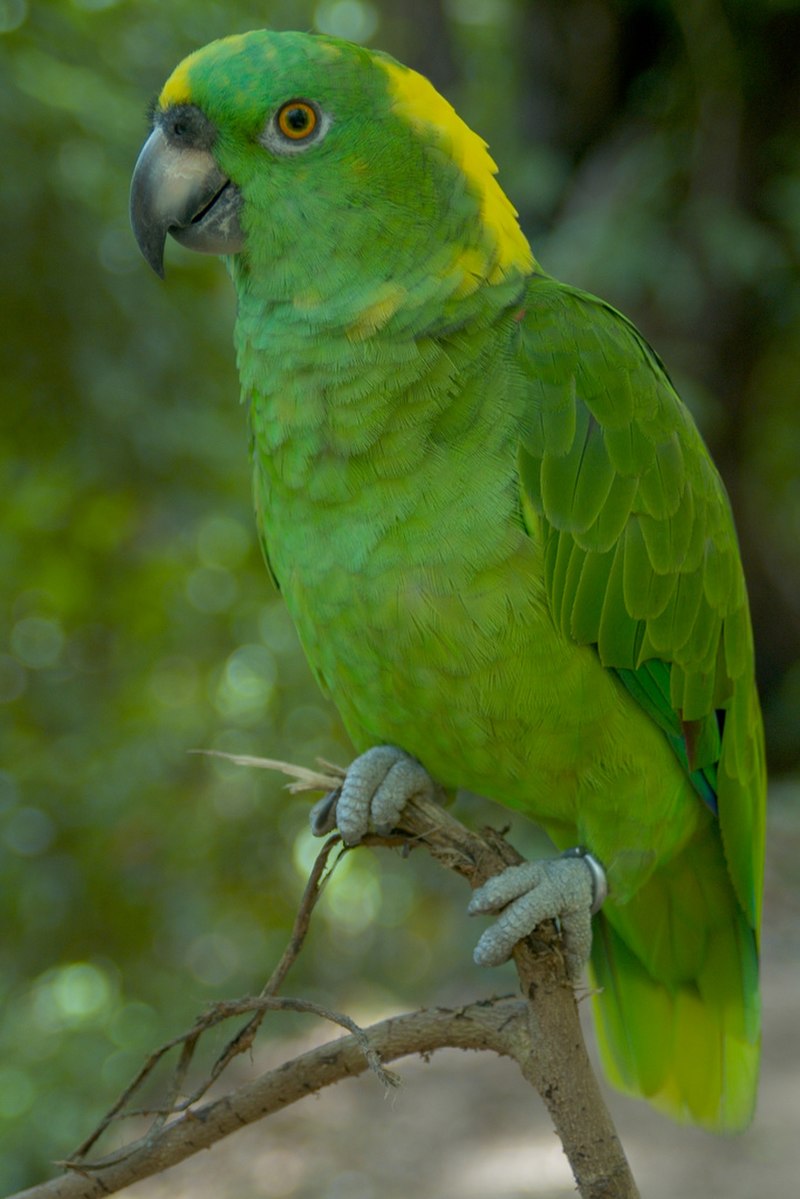
The Yellow-Naped Amazon is a beautiful parrot native to the Pacific coast of southern Mexico and Central America. Its vibrant yellow head feathers distinguish it from other species, making it an instantly recognizable bird.
This species has recently been classified as Critically Endangered due to its dramatic decline in population numbers over recent years.
The main threats this species faces are illegal trapping for the pet trade, habitat loss and fragmentation caused by deforestation and agricultural land conversion, as well as competition with locally introduced birds.
Conservation efforts must be implemented if we want to ensure that this majestic creature doesn’t disappear forever.
Scientific classification:
| Kingdom | Animalia |
| Phylum | Chordata |
| Class | Aves |
| Order | Psittaciformes |
| Family | Psittacidae |
| Genus | Amazona |
| Species | A. auropalliata |
10. Bushy-Crested Jay
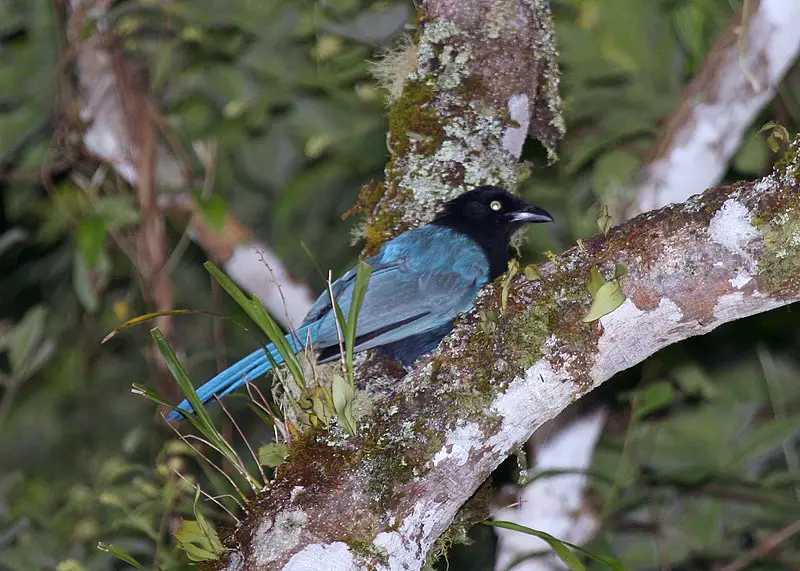
The Bushy-crested Jay is a species of bird found in Central America. It has two distinct subspecies, C. m. melanocyaneus located in Guatemala and El Salvador, and C.
m. chavezi which can be seen from Honduras to northeastern Nicaragua . This jay prefers moist montane forests or degraded former forest habitats as their home range .
They have an overall blue plumage with light gray underparts while the crest on its head is chestnut brown that contrasts greatly against its otherwise colored body.
The tail feathers are often barred black and white , giving it a unique look amongst other birds of similar size and coloration .
Their diet consists mostly of insects but they’ve been known to feed on fruits as well when available leading them to becoming seed dispersers for certain plant life throughout their habitat area.
All in all this species remains relatively common even though there may be some localized threats present due to deforestation activity happening within parts of Central America at times.
Scientific classification:
| Kingdom | Animalia |
| Phylum | Chordata |
| Class | Aves |
| Order | Passeriformes |
| Family | Corvidae |
| Genus | Cyanocorax |
| Species | C. melanocyaneus |
11. Turquoise-Browed Motmot
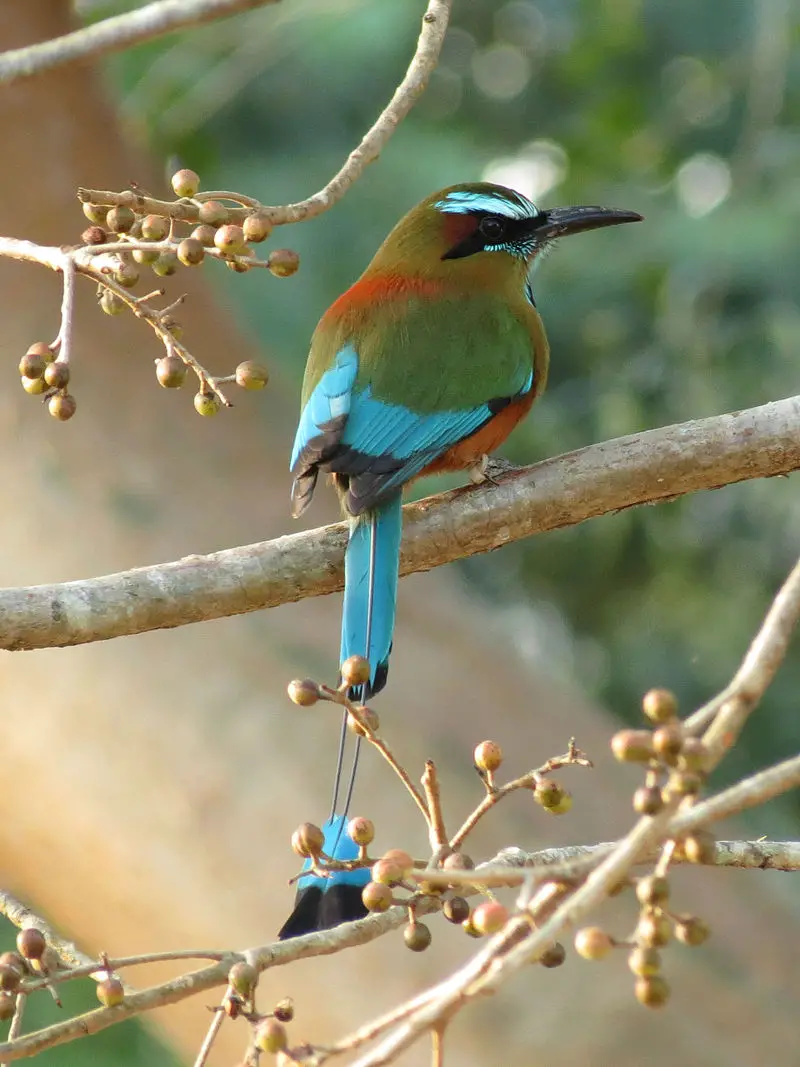
The turquoise-browed motmot is a beautiful bird of the Momotidae family. It can be found in central America from south east Mexico to Costa Rica, where it is common and not considered threatened.
This species enjoys living in open habitats such as forest edges, gallery forests or scrubland.
They are more visible than other Motmots due to their large size and bright colouration which includes an iridescent blue back and yellowish chest with black spots on its throat feathers.
Turquoise-browed motmots possess unique features that set them apart; they have two long tail feathers which dangle behind them while flying like streamers, hence earning themselves the nickname “the flying orchestra”.
In addition they are known for their loud calls during mating season – making them easily recognizable.
Scientific classification:
| Kingdom | Animalia |
| Phylum | Chordata |
| Class | Aves |
| Order | Coraciiformes |
| Family | Momotidae |
| Genus | Eumomota P.L. Sclater, 1858 |
| Species | E. superciliosa |
Also Featured In: Common Latin America Birds,
12. Blue-Throated Motmot
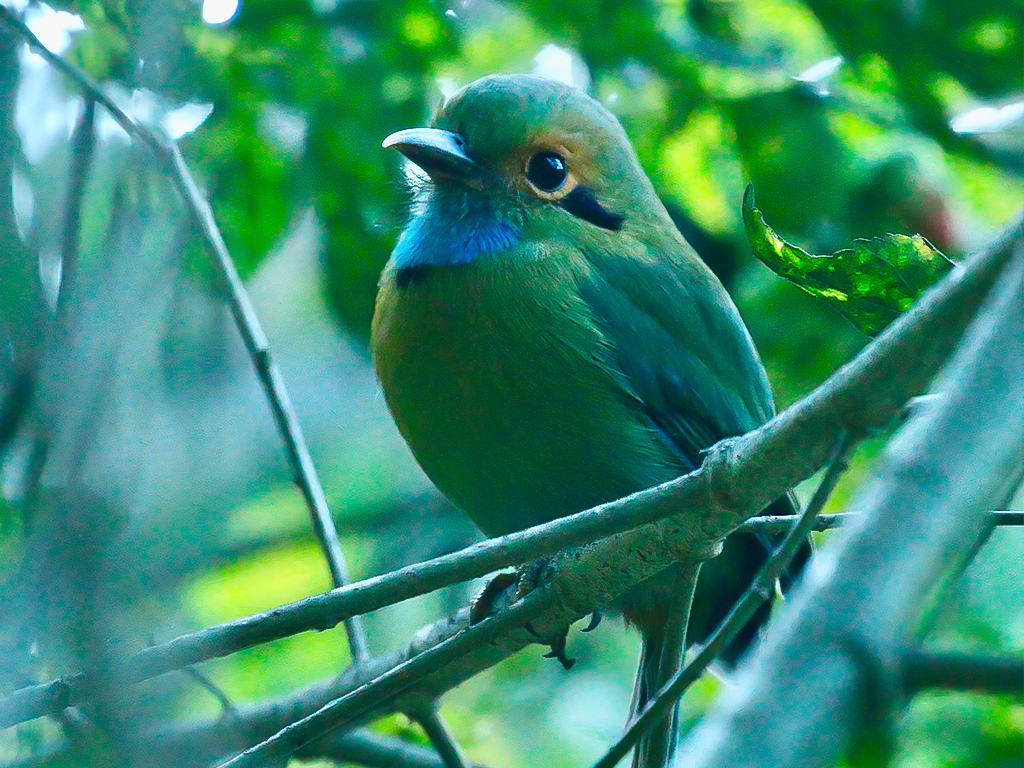
The Blue-throated Motmot is a unique bird found in El Salvador, Guatemala, Honduras and Mexico. It’s monotypic meaning it has no close relatives.
This stunning creature measures 25.5 to 28 cm long with a weight of 56 – 67 gm making them quite light for their size.
They are easily identifiable by their bright blue throat patch and green crown surrounded by black feathers that create an eye mask like effect on either side of the head.
The tail is also very distinct; being longer than most other birds with its two elongated central feathers trailing behind them as they fly or walk through dense vegetation searching for prey such as insects, lizards and small snakes.
All in all this beautiful species serves as reminder of the uniqueness our planet provides us with every day.
Scientific classification:
| Kingdom | Animalia |
| Phylum | Chordata |
| Class | Aves |
| Order | Coraciiformes |
| Family | Momotidae |
| Genus | Aspatha Sharpe, 1892 |
| Species | A. gularis |
13. True Owl
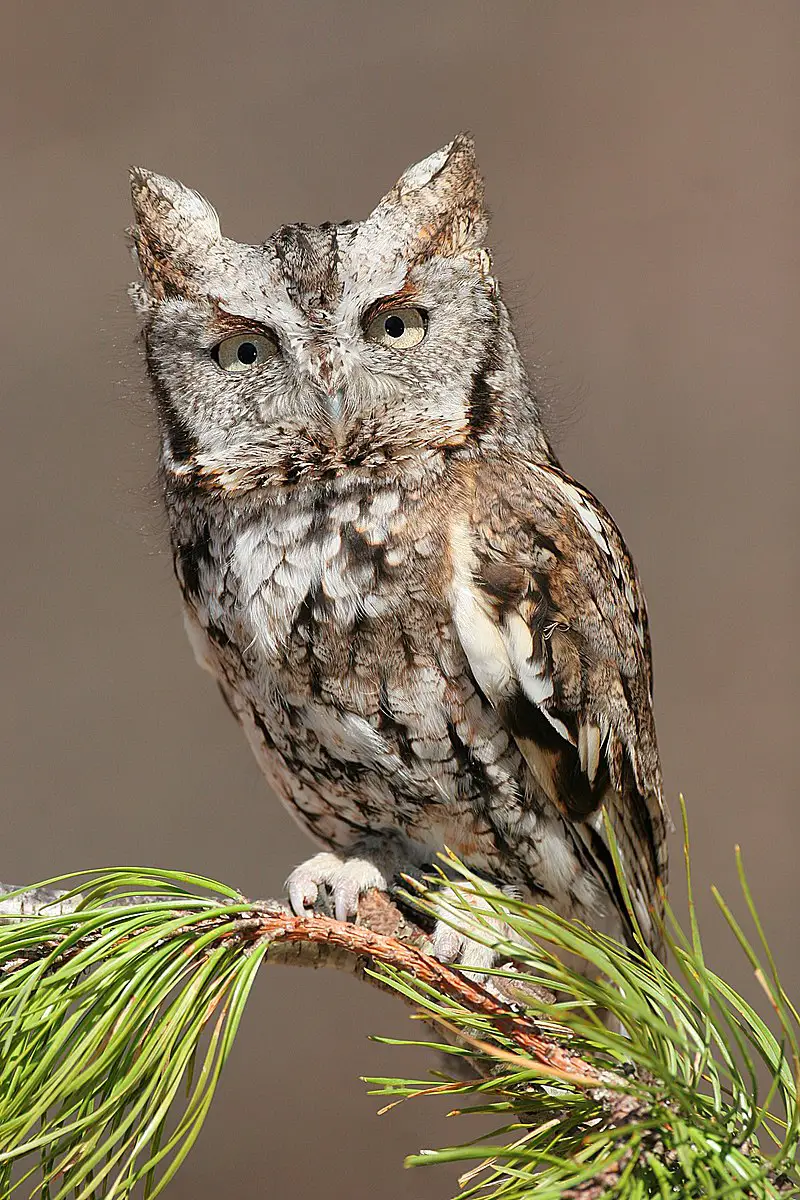
Owls are one of the two main families of owls, with Strigidae being the true owl family. With 230 species and 24 genera, this large bird family is found all around the world except for Antarctica.
Owls vary greatly in size and shape, but they typically have a round face with forward-facing eyes and a hooked bill to help them catch their prey.
They also possess asymmetrical ears that allow them to detect even faint sounds from great distances making them formidable predators at night.
Although solitary by nature, some species can be quite vocal while others may remain silent during daylight hours until sunset when they become active again looking for food under cover of darkness.
Scientific classification:
| Kingdom | Animalia |
| Phylum | Chordata |
| Class | Aves |
| Order | Strigiformes |
| Family | Strigidae Leach, 1820 |
14. Great Curassow
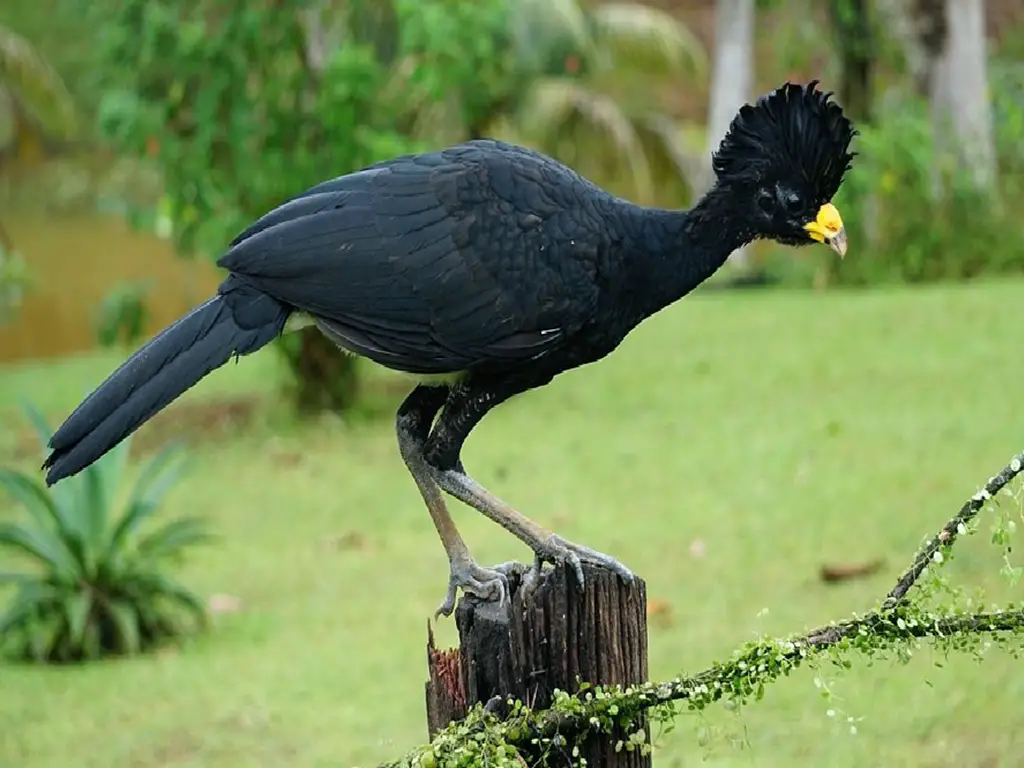
The Great Curassow is an impressive bird, found in the Neotropical rainforests. Males are easily identified by their black color and yellow beaks, while females come in three distinct morphs: barred, rufous or black.
These birds have a pheasant-like shape and can form small groups when foraging on the ground for fruits.
The range of this species extends from eastern Mexico to western Colombia and northwestern Ecuador; however they can also be seen in other regions like Costa Rica where conservation efforts are helping with population growth.
While not considered endangered yet, destruction of its natural habitat does pose threats to these majestic creatures if it’s not properly managed soon enough.
Scientific classification:
| Kingdom | Animalia |
| Phylum | Chordata |
| Class | Aves |
| Order | Galliformes |
| Family | Cracidae |
| Genus | Crax |
| Species | C. rubra |
Also Featured In: Most Common Birds in South America Birds,
15. Black-Headed Trogon
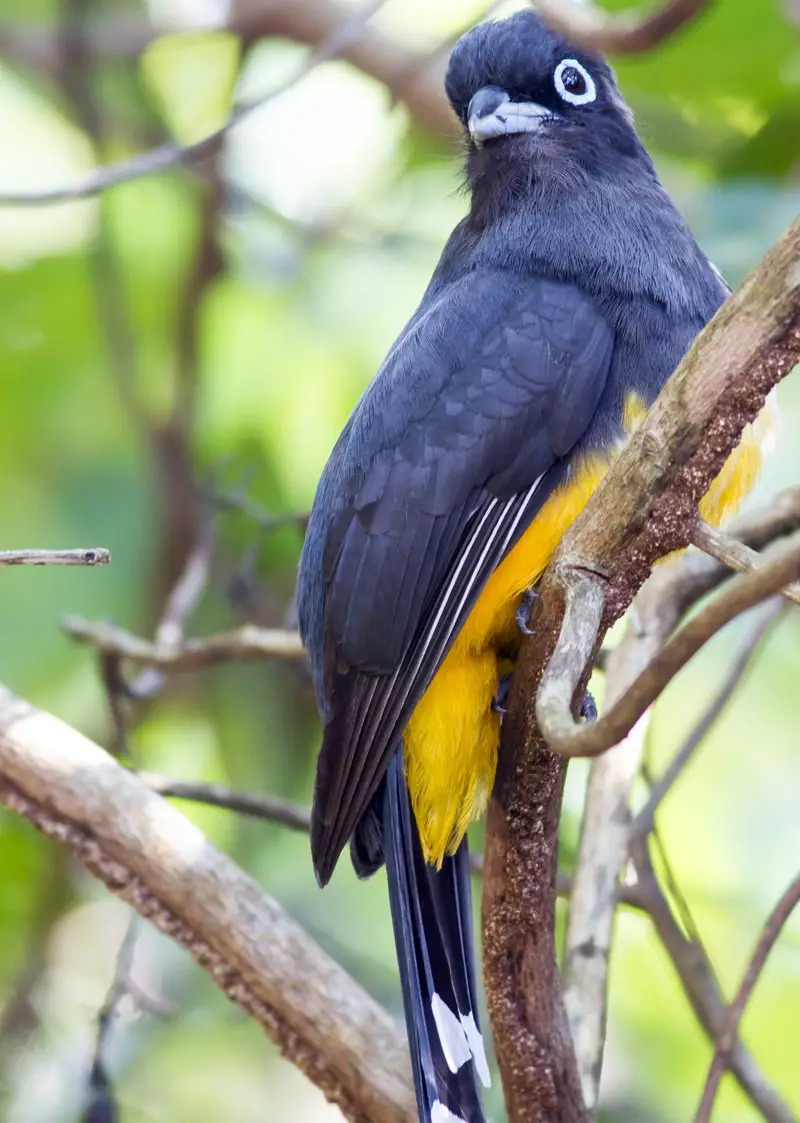
The Black-headed Trogon is a species of bird belonging to the family Trogonidae. It mainly resides in Central America, such as Belize, Costa Rica, El Salvador and Mexico.
The International Ornithological Committee and BirdLife International’s Handbook of the Birds of the World consider this species monotypic.
Clements taxonomy assigns it two subspecies – T. m. melanocephalus found from Honduras to Nicaragua; while T. m leucolaemus can be spotted in Guatemala and Chiapas (Mexico).
Its feathers are mostly black with white tips on wings & tail tip with red undertail coverts that make its appearance unique when seen against sunlight or bright background.
Scientific classification:
| Kingdom | Animalia |
| Phylum | Chordata |
| Class | Aves |
| Order | Trogoniformes |
| Family | Trogonidae |
| Genus | Trogon |
| Species | T. melanocephalus |
16. Black Hawk-Eagle
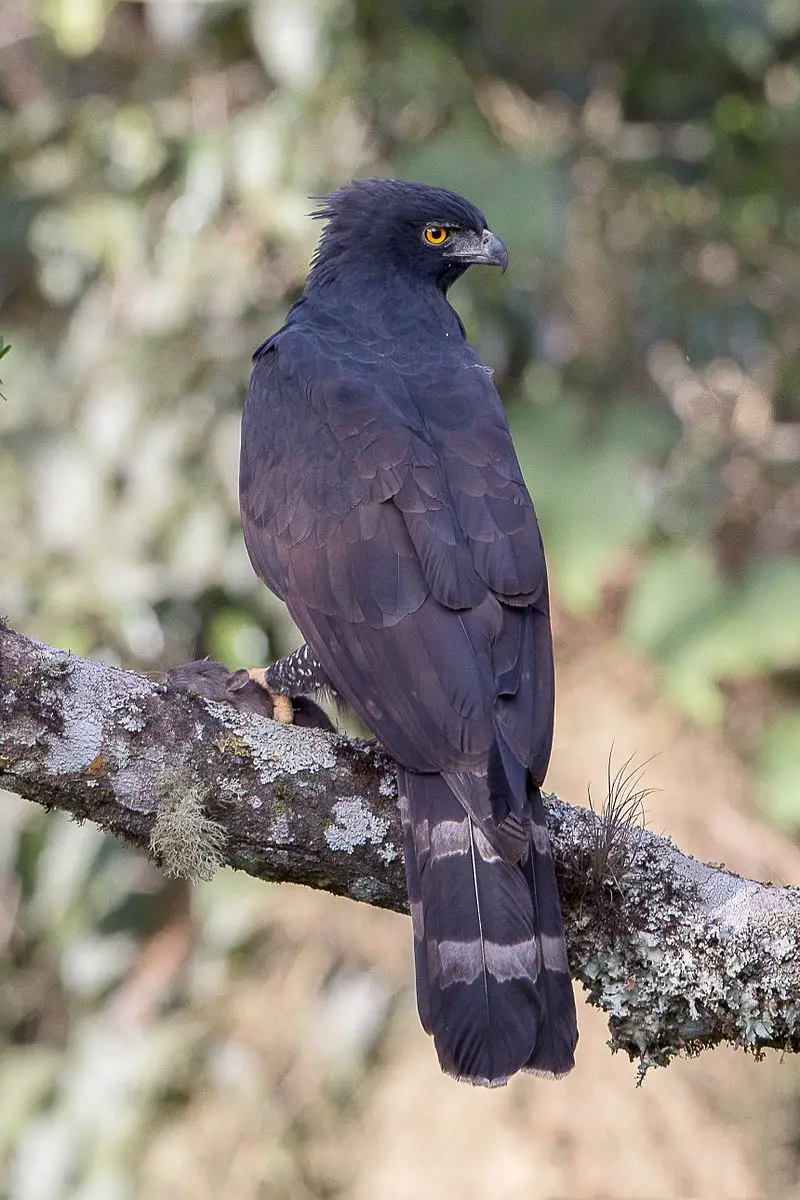
The Black Hawk-Eagle is a majestic bird of prey found throughout Central and South America. With its striking black plumage and distinctive white wing patches, this large eagle can soar gracefully in the air with ease.
It has two known subspecies: S.t tyrannus which is mostly found in Brazil and Argentina, while S. t serus inhabits other parts of Latin America such as Mexico to Colombia, eastern Peru, northern Argentina among others regions.
This beautiful raptor feeds mainly on small mammals like hares or birds but also enjoys carrion when available – it’s an opportunistic hunter that takes advantage of any food sources within reach.
The Black Hawk-Eagle plays an important role in many local ecosystems by controlling animal populations through predation yet they remain vulnerable due to habitat destruction from human activities such as urban expansion or unsustainable agricultural practices.
Scientific classification:
| Kingdom | Animalia |
| Phylum | Chordata |
| Class | Aves |
| Order | Accipitriformes |
| Family | Accipitridae |
| Genus | Spizaetus |
| Species | S. tyrannus |
17. Northern Potoo
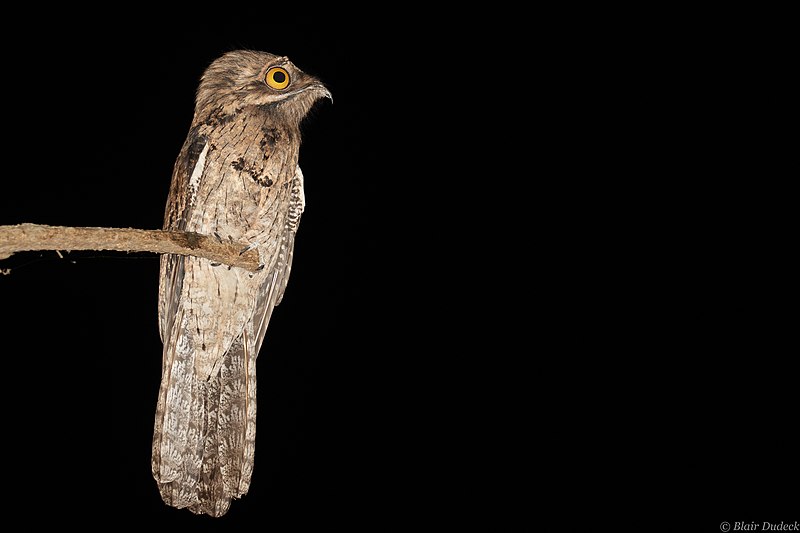
The Northern Potoo is a nocturnal bird belonging to the Nyctibiidae family. It inhabits Mexico, Central America and some of the Caribbean Islands such as Jamaica and Hispaniola where it can be found in tropical dry forests.
It was formerly classified as a subspecies of Common Potoo but due to differences in vocalizations they are now considered separate species.
This interesting bird has an almost comical appearance with its large head, long bill, short neck and disproportionately long legs that give it an awkward gait when walking on land.
Its plumage is mottled grey-brown which helps camouflage itself during the day while perched motionless on tree branches looking for prey at night.
The Northern Potoos call consists mostly or whistles ending with trills making them quite easy to identify within their range area.
Scientific classification:
| Kingdom | Animalia |
| Phylum | Chordata |
| Class | Aves |
| Order | Nyctibiiformes |
| Family | Nyctibiidae |
| Genus | Nyctibius |
| Species | N. jamaicensis |
18. Stone-Curlew

Stone-curlews, also known as dikkops or thick-knees, are a family of birds that have adapted to live in tropical and temperate regions throughout the world.
They can be found in Africa, Asia and Australia with two or more species per region. Despite being classified as waders, most prefer dry arid habitats over moist wetlands.
Stone-curlews typically have long legs which help them navigate through their preferred terrain efficiently; some species even stand at an impressive height when standing on those long legs.
Additionally they feature cryptic plumage which helps them blend into their surroundings while hunting for prey such as insects and small mammals like rodents.
These unique bird’s calls are easily recognizable; it has been said that hearing one is similar to listening to someone whistling ‘Keee Weee’.
Scientific classification:
| Kingdom | Animalia |
| Phylum | Chordata |
| Class | Aves |
| Order | Charadriiformes |
| Suborder | Chionidi |
| Family | Burhinidae Mathews, 1912 |
19. Threskiornithidae
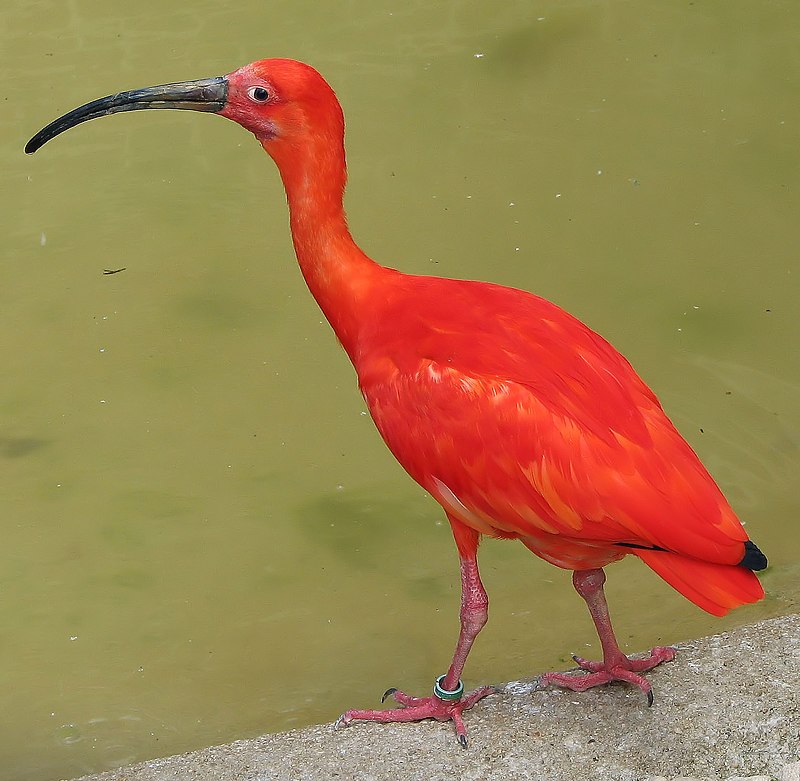
Threskiornithidae is a family of large wading birds which includes 36 species. These birds are traditionally divided into two subfamilies – the ibises and the spoonbills.
However, recent genetic analysis has shown that spoonbills actually belong to Old World ibis group, while New World ibises form an early offshoot from this lineage.
Threskiornithidse members have long curved beaks with serrated edges used for catching fish in shallow water or mudflats, as well as other aquatic invertebrates like crustaceans and mollusks.
They also feed on plant matter such as grains and seeds found close to wetlands areas where they live.
This diverse diet makes them important scavengers in their ecosystems, helping maintain healthy populations of native wildlife by controlling insect numbers and dispersing energy-rich seeds throughout wetland habitats.
Scientific classification:
| Kingdom | Animalia |
| Phylum | Chordata |
| Class | Aves |
| Order | Pelecaniformes |
| Suborder | Ardei |
| Family | Threskiornithidae Richmond, 1917 |
20. Heliornithidae
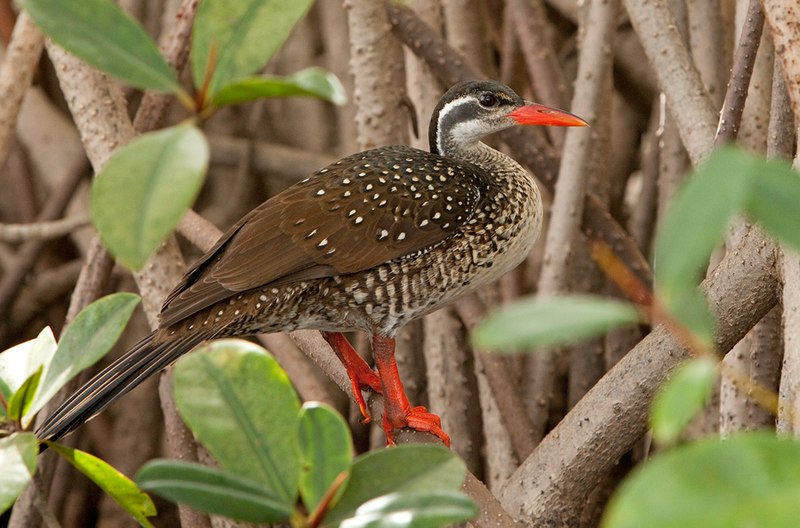
Heliornithidae, commonly known as finfoots, are a small family of tropical birds found in South America and Africa. They have webbed feet like grebes or coots, long necks, slender bodies and broad tails with sharp pointed bills.
Their diverse calls include whistles, squawks and croaks which they use to communicate with each other.
Finfoots feed mainly on fish but also consume insects such as water beetles and dragonflies near the surface of waterbodies.
They nest around rivers or lakes where there is plenty of cover from predators such as eagles or hawks.
During breeding season males can become quite territorial defending their territories against intruders by chasing them off aggressively using loud noises or even physical contact if necessary.
Scientific classification:
| Kingdom | Animalia |
| Phylum | Chordata |
| Class | Aves |
| Order | Gruiformes |
| Family | Heliornithidae GR Gray, 1840 |
21. New World Quail
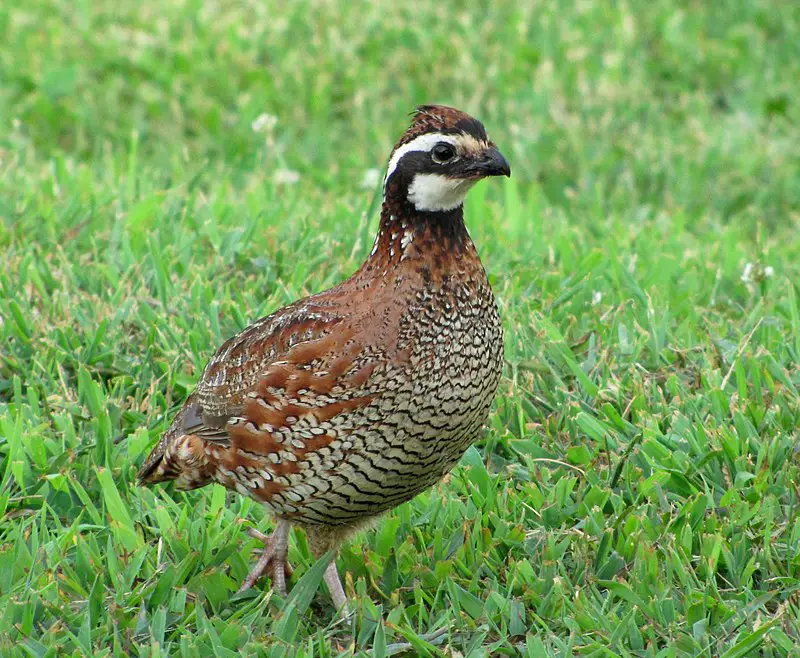
New World quail are small birds found in the Americas, from Canada to Brazil. They belong to their own family, Odontophoridae, and have similar appearance and habits as Old World quail which belong to a different family.
New World Quails come in various species such as California Quail and Bobwhite Quail.
These birds have adapted well to human presence due to availability of food resources like agricultural crops.
They also live close together where they form large flocks for safety against predators like foxes or hawks.
The males usually sport colorful feathers during mating season that helps them attract female mates while providing an amazing sight for us viewers.
Scientific classification:
| Kingdom | Animalia |
| Phylum | Chordata |
| Class | Aves |
| Order | Galliformes |
| Superfamily | Phasianoidea |
| Family | Odontophoridae Gould, 1844 |
22. Puffbird
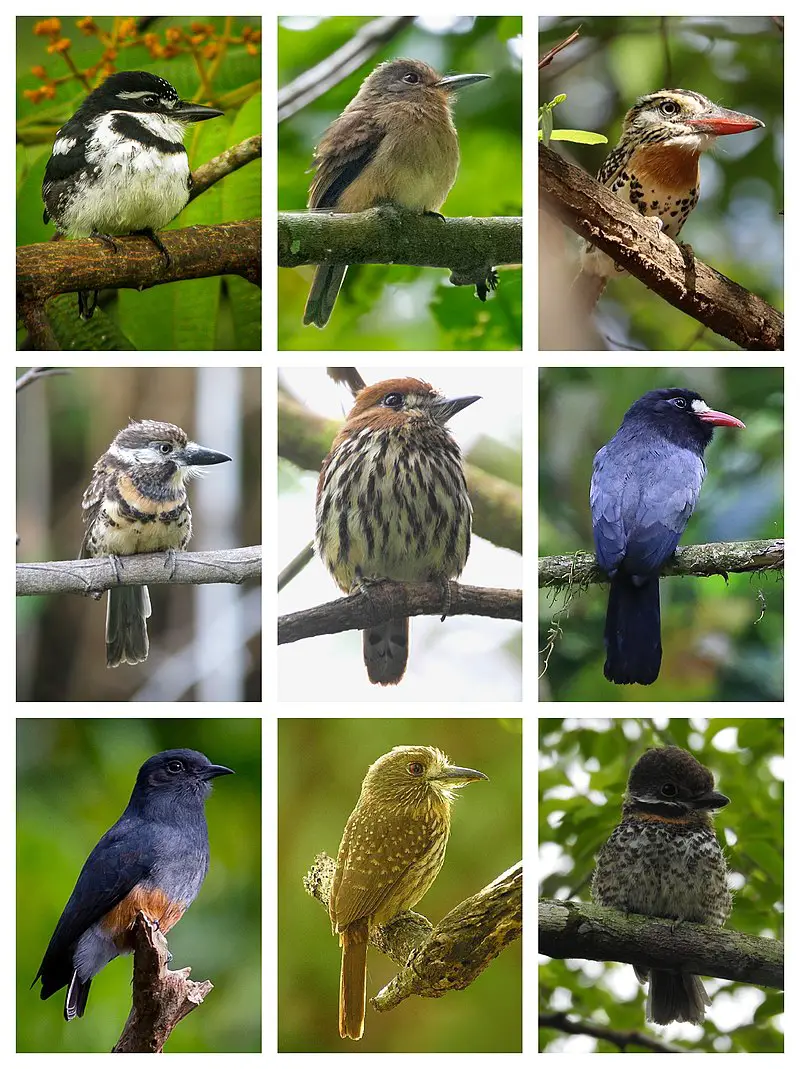
The Puffbird is a tropical tree-dwelling bird found in South America, Mexico and Central America.
It belongs to the near passerine family Bucconidae, which also includes jacamars – its closest relatives.
The order Piciformes unites these two families although some consider them separate under Galbuliformes.
Unlike other birds of the same group that have dazzling iridescent feathers, puffbirds are more modestly coloured with their greyish brown plumage blending into their environment for camouflage purposes when perched on trees or shrubs searching for insects as food sources using their long pointed bill.
They can be quite difficult to spot due to being small and well camouflaged but they may give away their presence by calling out loudly with an unmistakable whistling sound.
Scientific classification:
| Kingdom | Animalia |
| Phylum | Chordata |
| Class | Aves |
| Order | Piciformes |
| Suborder | Galbuli |
| Family | Bucconidae Horsfield, 1821 |
23. Jacamars
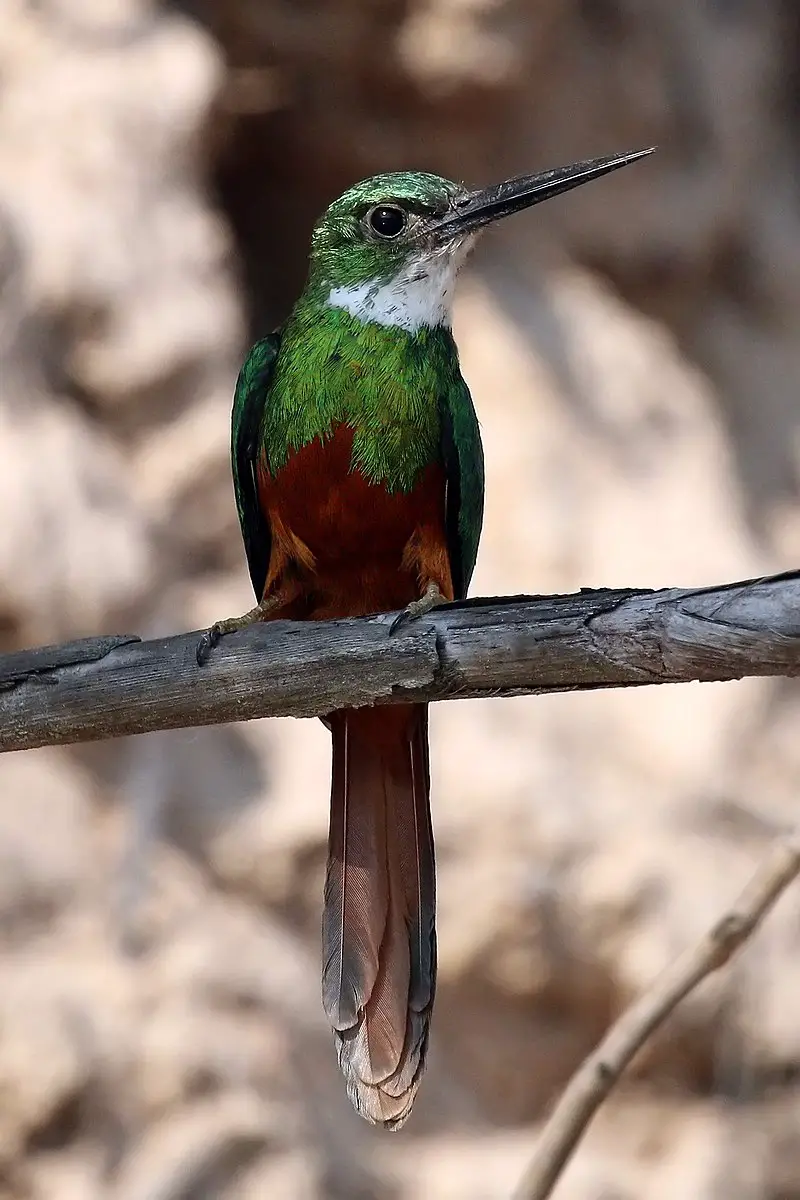
Jacamars are tropical birds native to South and Central America, extending as far north as Mexico. They belong to the Galbulidae family which consists of five genera and eighteen species in total.
These captivating birds can be easily distinguished by their unique appearance; they have long sharp bills with bright vivid plumage ranging from blues, greens and yellows that create a beautiful contrast against the lush vegetation of their natural habitat.
Jacamars prefer to inhabit dense forested areas near rivers or streams where they use their agile wings for quick flight maneuvers while hunting insects, lizards and frogs.
With an unmistakable presence these fascinating feathered creatures make a remarkable addition to any backyard bird sanctuary.
Scientific classification:
| Kingdom | Animalia |
| Phylum | Chordata |
| Class | Aves |
| Order | Piciformes |
| Suborder | Galbuli |
| Family | Galbulidae Vigors, 1825 |
24. Stilts And Avocets
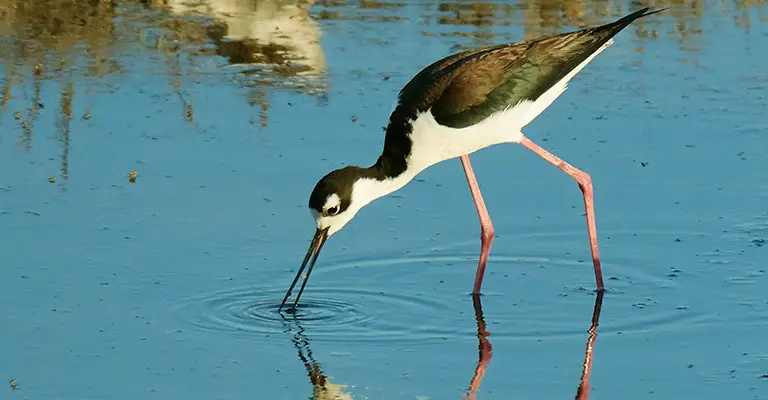
Stilts and avocets are two distinct groups of birds belonging to the family Recurvirostridae. They range in length from 30-46 cm (12-18 inches) and weigh between 140 – 435 g (4.9 – 15.3 ounces).
Males usually have slightly larger bodies than females, with long thin legs, necks and bills.
Avocet bills curve upwards uniquely while stilt beaks remain straight most times.
These wading birds live mainly near shorelines or wetlands where they feed on aquatic invertebrates like brine shrimp, insects etc., occasionally supplementing their diet with seeds or small fish too.
Stilts also inhabit open fields in search of food sources such as earthworms or grasshoppers during the non-breeding season.
Both groups migrate over large distances for warmer weathers when it gets cold outside.
Scientific classification:
| Kingdom | Animalia |
| Phylum | Chordata |
| Class | Aves |
| Order | Charadriiformes |
| Suborder | Charadrii |
| Family | Recurvirostridae Bonaparte, 1854 |
25. Keel-Billed Motmot
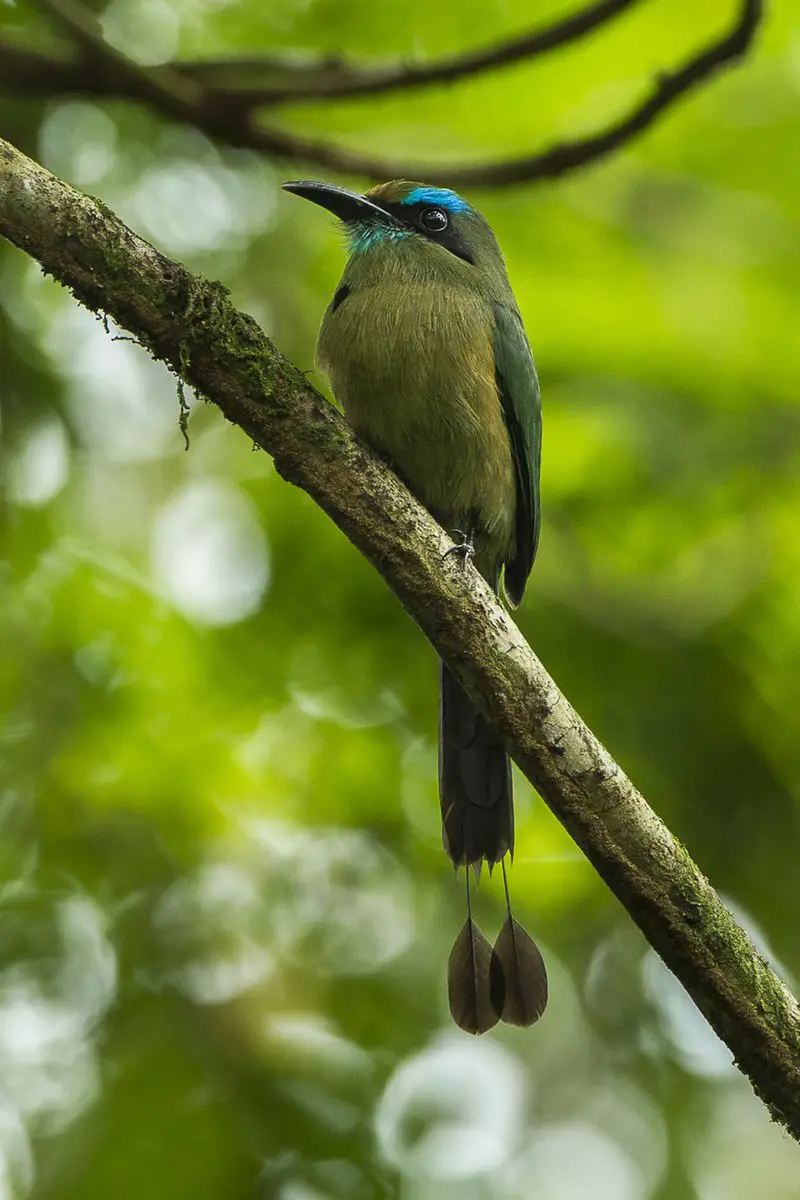
The keel-billed motmot is a species of bird belonging to the Momotidae family, closely related to its cousin the broad-billed motmot.
It has a distinct plumage and can be found in Belize, Costa Rica, Guatemala, Honduras, Nicaragua and Mexico.
This medium sized bird typically measures up to 30 cm long with distinctive colors ranging from greenish blue above and yellow below with black streaks on wings while having bright orange red bill with black tip featuring unique ‘keeled’ appearance that gives this species its name.
The call of these birds are generally loud whistles made out of two notes which differentiate it from other Motmots.
They mostly feed on insects such as ants or beetles alongwith fruits like berries or small lizards and frogs occasionally when available.
These colorful birds inhabit tropical forests making them an interesting sight for tourists visiting different places in Central America where they live.
Scientific classification:
| Kingdom | Animalia |
| Phylum | Chordata |
| Class | Aves |
| Order | Coraciiformes |
| Family | Momotidae |
| Genus | Electron |
| Species | E. carinatum |
26. White-Fronted Amazon
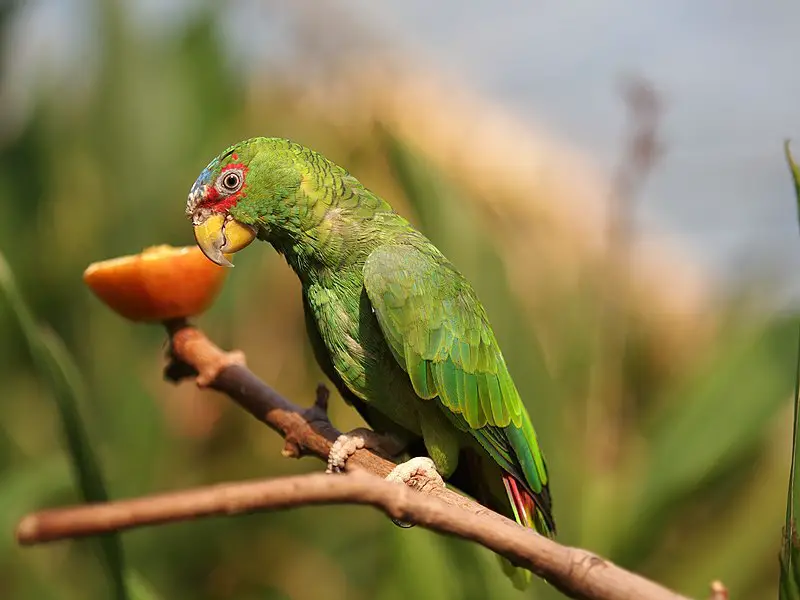
The white-fronted amazon is a Central American parrot that stands out for its bright colouring and ability to imitate around 40 different sounds.
It has an average life span of about 40 years, making it one of the longest living parrots in existence.
Despite being the smallest species among large parrots, measuring 25cm long, this bird still possesses strong vocal chords which can be heard from great distances.
They have beautiful yellow heads with distinctive white patches on their forehead and grey feathers covering their wings and tail.
These birds are very social animals who live in pairs or family groups within tropical rainforests and wetlands where they feed mostly on seeds found in trees such as palms.
Scientific classification:
| Kingdom | Animalia |
| Phylum | Chordata |
| Class | Aves |
| Order | Psittaciformes |
| Family | Psittacidae |
| Genus | Amazona |
| Species | A. albifrons |
Also Featured In: Birds that You’ll Find in Chiapas, Most Common Oaxaca Birds
27. Blue-Tailed Hummingbird

The Blue-tailed Hummingbird is a small species of hummingbird found in Central America. It is renowned for its bright blue tail and long wings, which allow it to hover easily over flowers while feeding on nectar.
This bird also has an emerald green back that stands out against the surrounding foliage. Its diet consists mainly of insects, but they will occasionally feed on fruit as well.
They are known to be quite territorial when defending their food sources or nesting sites from other birds and animals alike.
The Blue-tailed Hummingbird can often be seen perched atop tall branches surveying its surroundings during the day before returning to their nests at nightfall.
With its vibrant colors and beautiful display of flight, this amazing creature truly adds color and life to any environment it calls home.
Scientific classification:
| Kingdom | Animalia |
| Phylum | Chordata |
| Class | Aves |
| Order | Apodiformes |
| Family | Trochilidae |
| Genus | Saucerottia |
| Species | S. cyanura |
28. Yucatan Nightjar
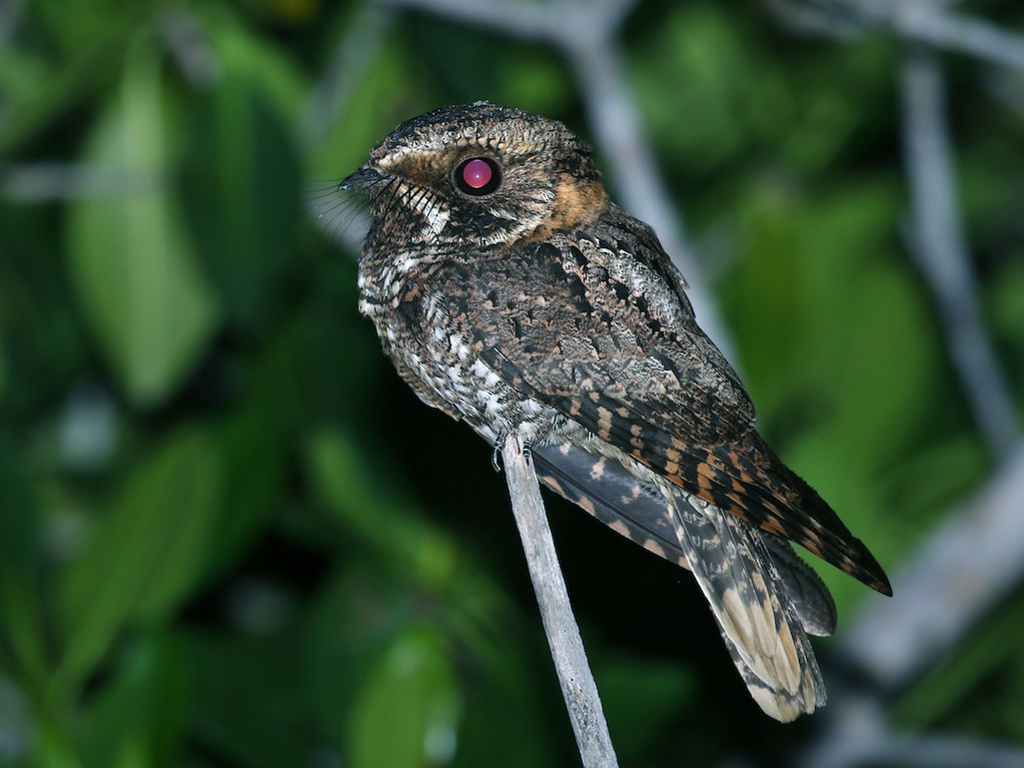
The Yucatan nightjar is a species of bird belonging to the family Caprimulgidae. It is found in Belize, Guatemala, Mexico and Honduras. This nocturnal bird has distinct brownish-black plumage with light streaks on its wings and tail feathers.
Its call consists of a series of distinctive chirps that can be heard during nighttime hours. These birds feed mainly on insects but will also take small reptiles or amphibians if the opportunity presents itself.
They are most active at dusk when they come out to hunt for food as well as socialize with other members of their species before returning back to their roosts shortly after dawn breaks.
The Yucatan nightjar’s population numbers have been decreasing due to habitat destruction caused by human activities such as deforestation and agricultural expansion which has lead it being listed as Near Threatened according IUCN Red List criteria assessment from 2018 onwards.
Scientific classification:
| Kingdom | Animalia |
| Phylum | Chordata |
| Class | Aves |
| Order | Caprimulgiformes |
| Family | Caprimulgidae |
| Genus | Antrostomus |
| Species | A. badius |
Also Featured In: Most Common Birds You’ll Find in Quintana Roo, Cozumel Birds You Didn’t Know
29. Berylline Hummingbird
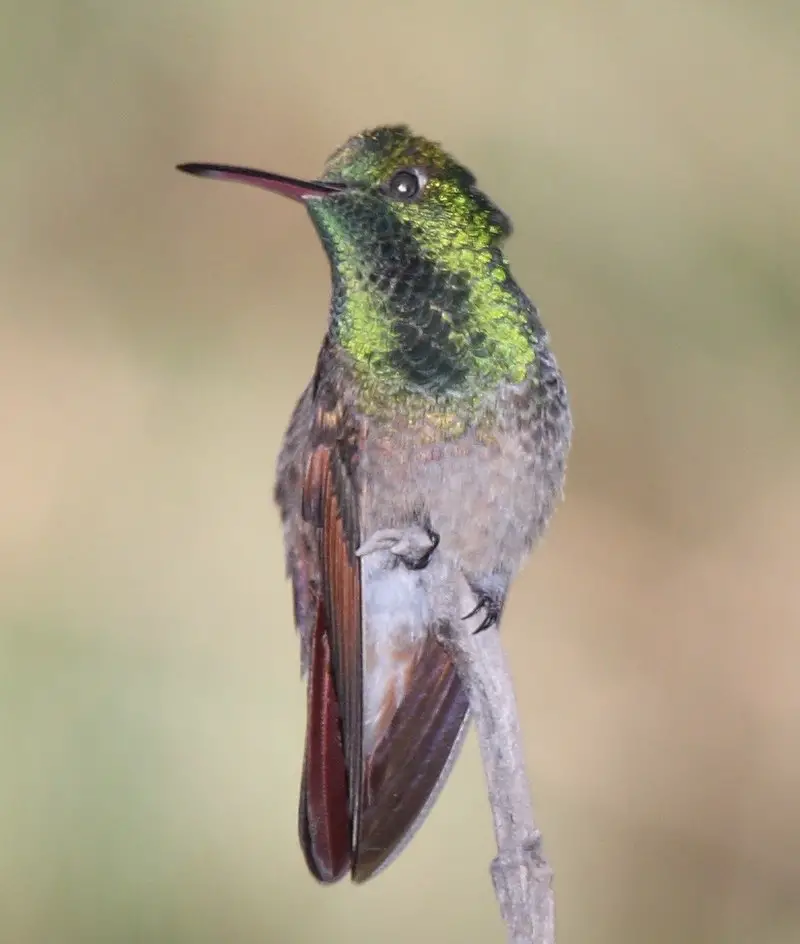
The Berylline Hummingbird is a vibrant species of hummingbird found in Central America and the United States.
It has emerald green upperparts, rufous sides and underparts, white tips to its tail feathers, as well as an iridescent purple throat patch.
These birds are highly territorial and will defend their territories against intruders with impressive aerial displays.
They feed on nectar from flowers such as bromeliads, columbines or agaves while searching for insects which they catch mid-air by hovering near foliage or flying low over meadows.
The Berylline Hummingbird is considered a Least Concern species due to its wide distribution range but it faces threats from habitat loss caused by urbanization and farming practices that reduce suitable nesting sites available for this bird.
Scientific classification:
| Kingdom | Animalia |
| Phylum | Chordata |
| Class | Aves |
| Order | Apodiformes |
| Family | Trochilidae |
| Genus | Saucerottia |
| Species | S. beryllina |
30. Buff-Collared Nightjar
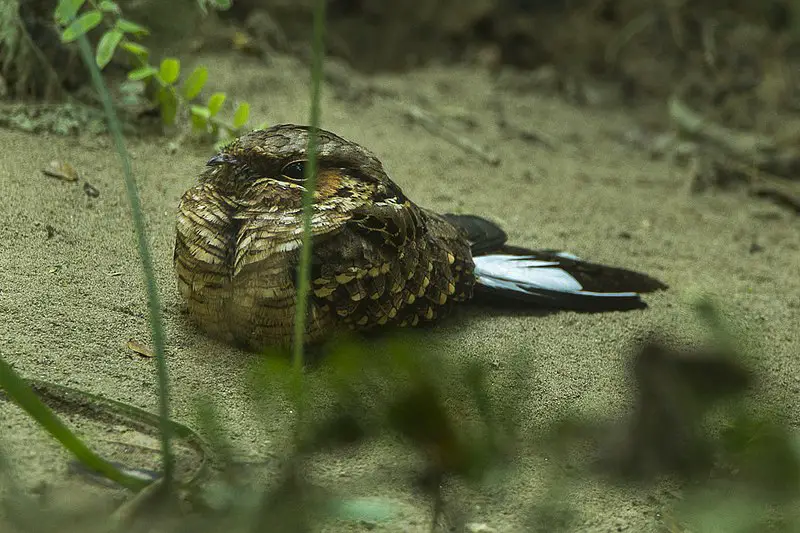
The Buff-collared Nightjar is a species of nightjar found in parts of Central America and the southwestern US. Its scientific name is Antrostomus ridgwayi, named after ornithologist Robert Ridgway.
It has two subspecies; A. r.ridgwayi and A.r troglodytes which were once included in genus Caprimulgidae due to their similar features with other nightjars from this family such as having long wings and tails for soaring at high altitudes over open areas during migrations or hunting prey like moths, beetles, crickets etc .
The buff-collar on its chest allows them to camouflage easily among tree branches helping it blend into its surroundings while roosting during daytime hours making them difficult to spot by predators or humans alike.
Scientific classification:
| Kingdom | Animalia |
| Phylum | Chordata |
| Class | Aves |
| Order | Caprimulgiformes |
| Family | Caprimulgidae |
| Genus | Antrostomus |
| Species | A. ridgwayi |
31. Black-Crested Coquette
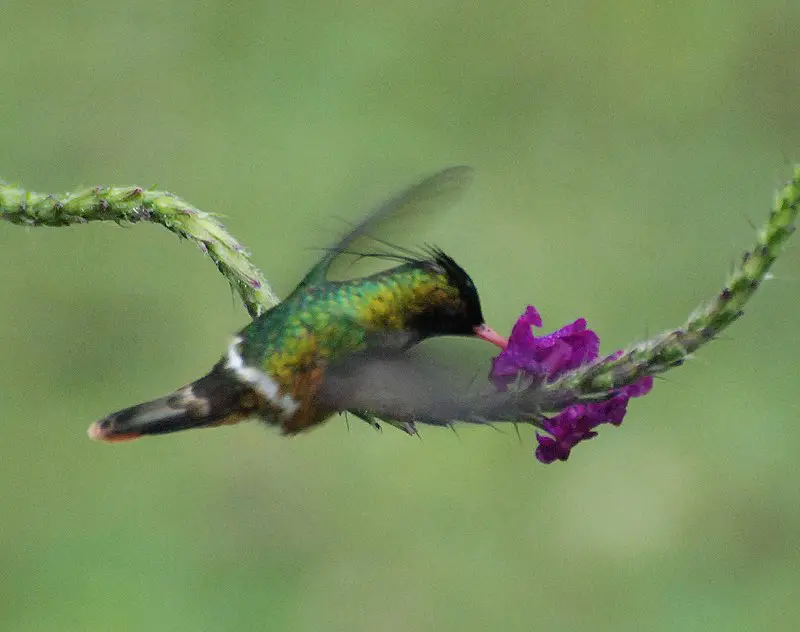
The Black-crested Coquette is a species of hummingbird that inhabits Belize, Costa Rica, Guatemala, Honduras, Mexico and Nicaragua. It has a striking black crest atop its small body which makes it easy to spot in the wild.
Its wings are short but powerful enabling it to hover over flowers while feeding on nectar with its long bill.
The male also performs elaborate courtship displays in order to attract female mates during breeding season by spreading an iridescent throat patch as well as doing aerial dives from high up above trees or shrubs.
This bird typically nests near low vegetation such as bamboo thickets due to their preference for staying close the ground so they can quickly take off if disturbed or threatened by predators or humans nearby.
Scientific classification:
| Kingdom | Animalia |
| Phylum | Chordata |
| Class | Aves |
| Order | Apodiformes |
| Family | Trochilidae |
| Genus | Lophornis |
| Species | L. helenae |
32. Buffy-Crowned Wood Partridge
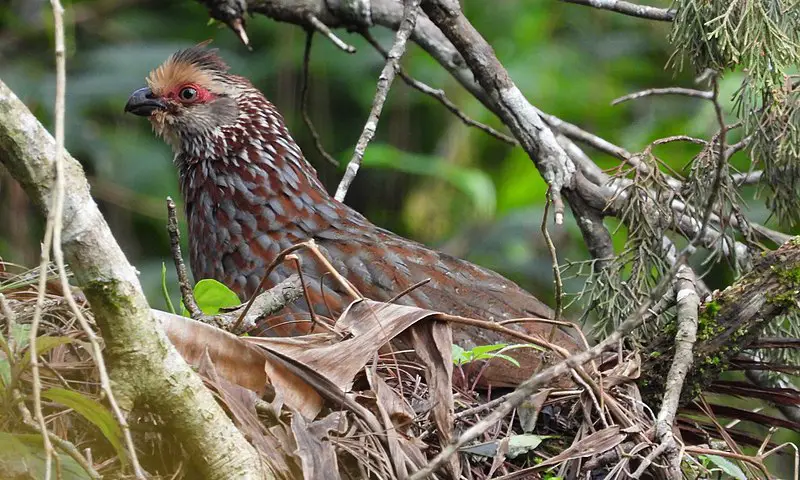
The Buffy-crowned Wood Partridge is a species of New World quail that can be found in Mexico, Guatemala, Honduras, El Salvador, Costa Rica and Nicaragua.
It was first discovered by Adolphe Delattre in Cobán, Guatemala back in 1843. Its unique features include its buffy crown feathers along with white spots on the belly and nape area.
In addition to this it also has long spurs which are used for protection against predators. The birds diet consists mainly of seeds but they will occasionally eat insects as well.
They prefer open areas such as pastures or grasslands where there is plenty of cover from tall vegetation so they can stay hidden from potential threats while still being able to spot their prey easily enough.
Scientific classification:
| Kingdom | Animalia |
| Phylum | Chordata |
| Class | Aves |
| Order | Galliformes |
| Family | Odontophoridae |
| Genus | Dendrortyx |
| Species | D. leucophrys |
33. Band-Tailed Barbthroat
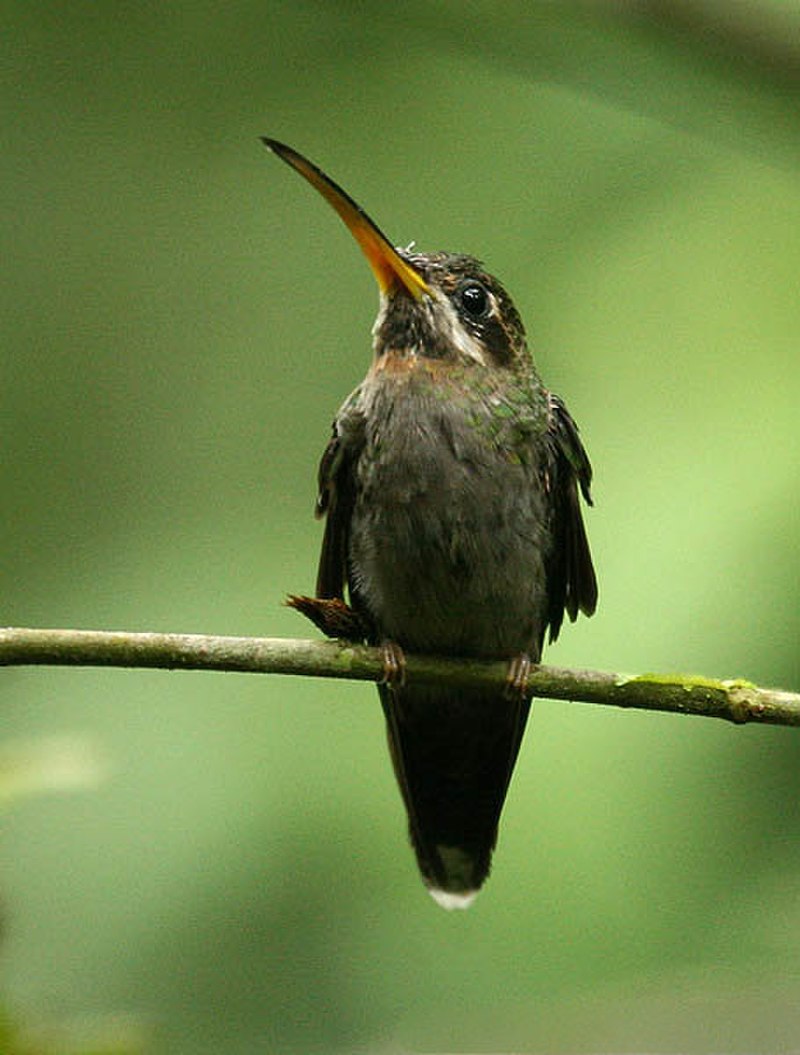
The Band-tailed Barbthroat is a medium sized hummingbird found in Central and South America. Its habitat ranges from southeastern Guatemala to western Venezuela, making it widespread throughout the region.
The bird has three recognized subspecies: T. ruckeri, T. hypostictus, and T. cinereicauda, as well as a fourth proposed subspecies of the Panama-Colombia border area known as darienensis that shares characteristics with all three others species of this bird family.
This unique looking creature has an emerald green back that fades into white towards its tail feathers which are tipped with black bands giving them their name ‘Band-tailed’. T
hey also have small yellow spots on their cheeks and throat along with distinctive pale brown tips at the end of each feather giving them a stunning complexity when displayed fully during flight or perched on tree branches for rest or searching for food like nectar from flowers or insects caught midair.
Scientific classification:
| Kingdom | Animalia |
| Phylum | Chordata |
| Class | Aves |
| Order | Apodiformes |
| Family | Trochilidae |
| Genus | Threnetes |
| Species | T. ruckeri |
34. Green-Breasted Mango
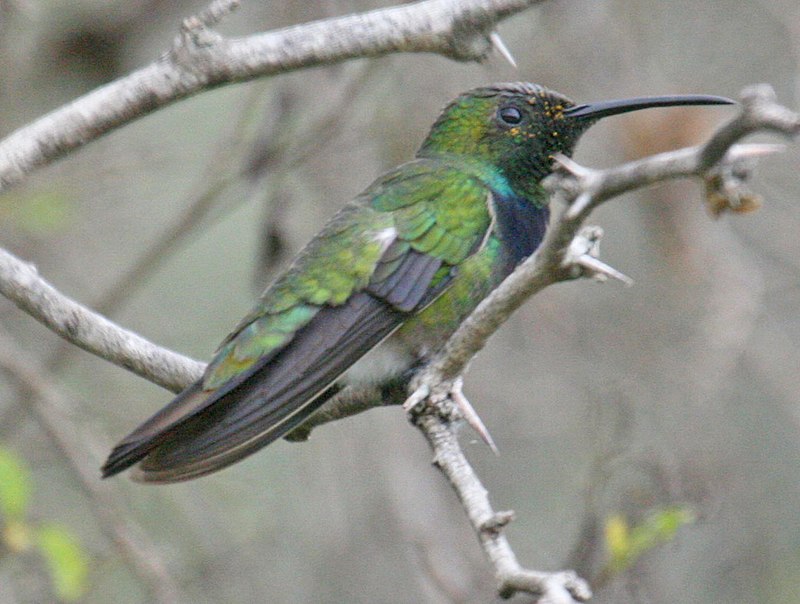
The Green-breasted Mango is a medium-sized hummingbird found in tropical America. The male has an impressive green chest and black bill, while the female’s feathers are more muted with greyish brown tones.
Both sexes have dark central tail feathers but males also feature bright white patches on their flanks.
They measure 11–12 cm long, with males weighing 7.2 g and females 6.8 g – making them slightly smaller than other species of hummingbirds such as the Ruby Throated Hummingbird which can reach up to 16 cm in length.
The scientific name of this fascinating bird commemorates French naturalist Florent Prévost – a fitting homage to its beauty.
Scientific classification:
| Kingdom | Animalia |
| Phylum | Chordata |
| Class | Aves |
| Order | Apodiformes |
| Family | Trochilidae |
| Genus | Anthracothorax |
| Species | A. prevostii |
Also Featured In: Green Birds in That Live in Texas, Hummingbirds Live around Florida
35. Slaty-Tailed Trogon
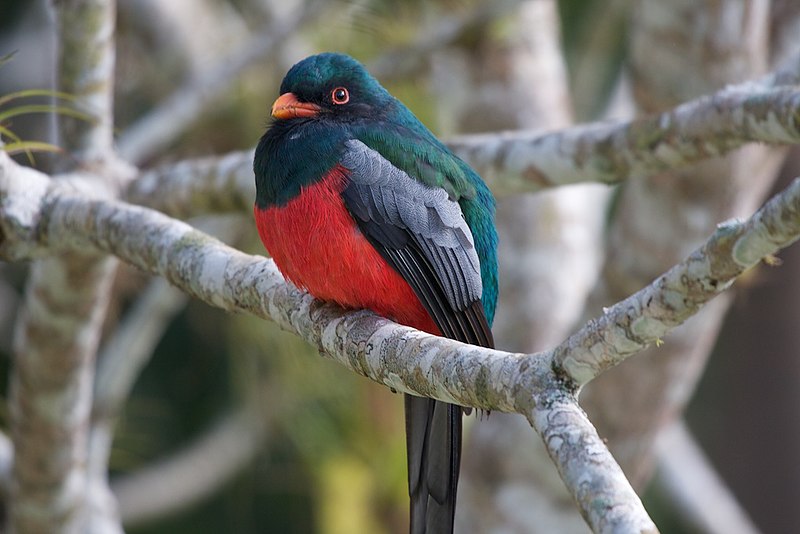
The Slaty-tailed Trogon is a medium sized bird that can be found in Mexico, Central America, Colombia and Ecuador. It has three subspecies – the nominate T.
m. massena, T. m Hoffmannni and T Austrialis which have sometimes been treated as separate species from the Black tailed trogon family instead of its own subspecies due to their distinct physical traits such as size differences or color variations like head feathers with darker shades than usual for the slaty tailed variety.
The wingspan of this beautiful bird ranges between 29cm – 34 cm while they weigh around 85g – 111g on average depending upon gender and other factors making them quite light weight compared to most birds in similar size range.
They also possess unique features such as long scaly tails at backside giving them an impressive look when soaring up high into sky.
Scientific classification:
| Kingdom | Animalia |
| Phylum | Chordata |
| Class | Aves |
| Order | Trogoniformes |
| Family | Trogonidae |
| Genus | Trogon |
| Species | T. massena |
36. Rufous-Tailed Hummingbird
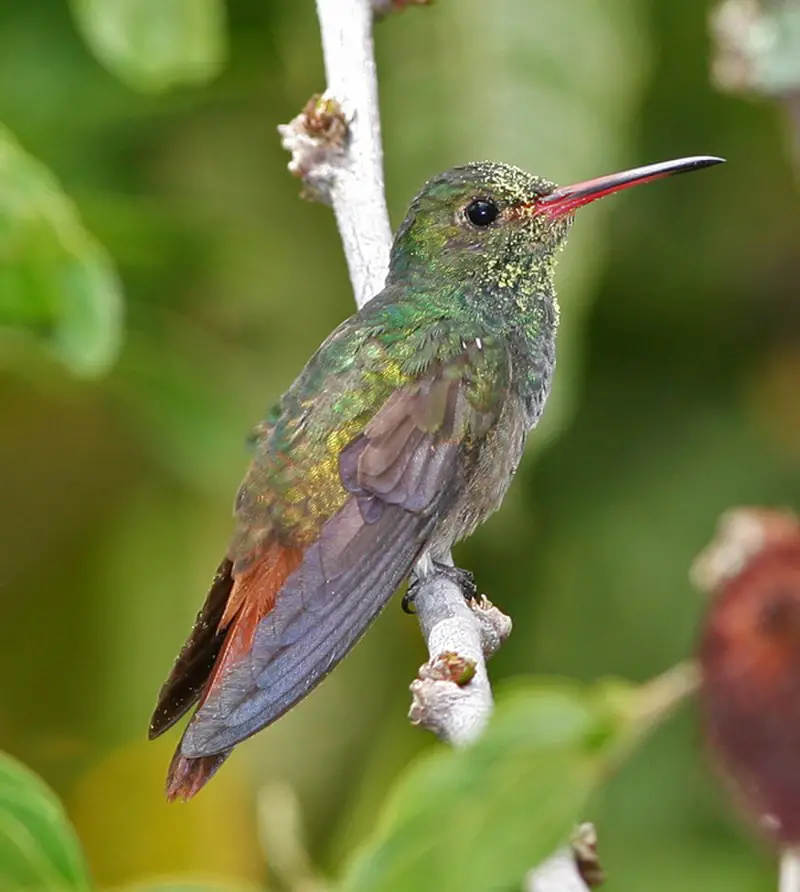
The rufous-tailed hummingbird is a medium-sized bird that belongs to the Trochilini tribe of subfamily Trochilinae. It can be found in east-central Mexico, Central America, Colombia, Ecuador and Venezuela.
This species was formally described back in 1833 by Mexican naturalist Pablo de La Llave who placed it in the genus Trochlilus and gave it its scientific name Amazilia tzacatl.
Its body has a brownish color with an orangey tail which helps distinguish it from other species.
The male’s throat also features bright blue tones on top of its light green feathers creating an eyecatching look when seen up close.
These birds feed mainly on nectar but will sometimes hunt for small insects as well; they are capable of flying at speeds reaching up to 34 mph.
Scientific classification:
| Kingdom | Animalia |
| Phylum | Chordata |
| Class | Aves |
| Order | Apodiformes |
| Family | Trochilidae |
| Genus | Amazilia |
| Species | A. tzacatl |
37. Great Green Macaw
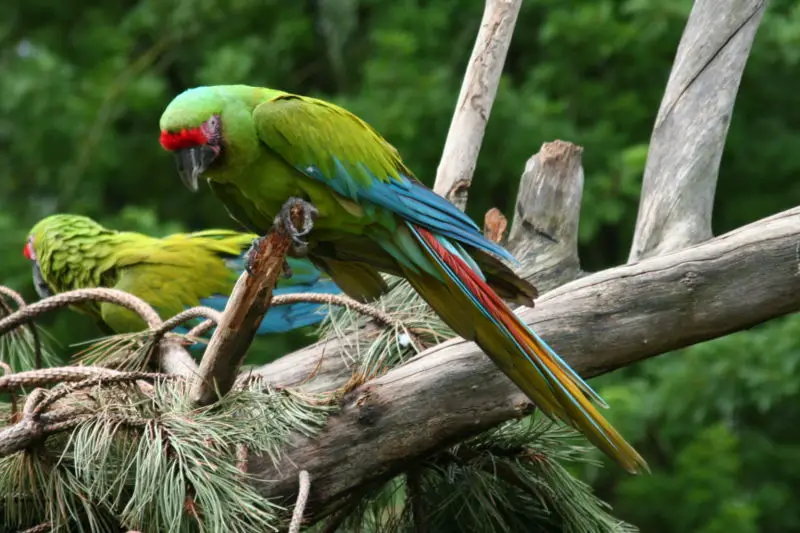
The great green macaw is a beautiful Central and South American parrot that can be found from Honduras to Colombia as well as Nicaragua, Costa Rica, Panama, and Ecuador.
With its bright red forehead, yellow cheeks and blue wings it’s easy to spot in the wild.
This magnificent bird has two recognized subspecies; Ara ambiguus ssp. ambiguus which ranges across most of its range while Ara ambiguus ssp. guayaquilensis appears exclusive to northwestern Ecuador.
These birds are usually seen foraging for seeds but their diet also includes fruits such as figs or palm nuts making them an important part of tropical ecosystems.
Scientific classification:
| Kingdom | Animalia |
| Phylum | Chordata |
| Class | Aves |
| Order | Psittaciformes |
| Family | Psittacidae |
| Genus | Ara |
| Species | A. ambiguus |
Also Featured In: Common Tropical Rainforest Birds,
38. Red-Capped Manakin
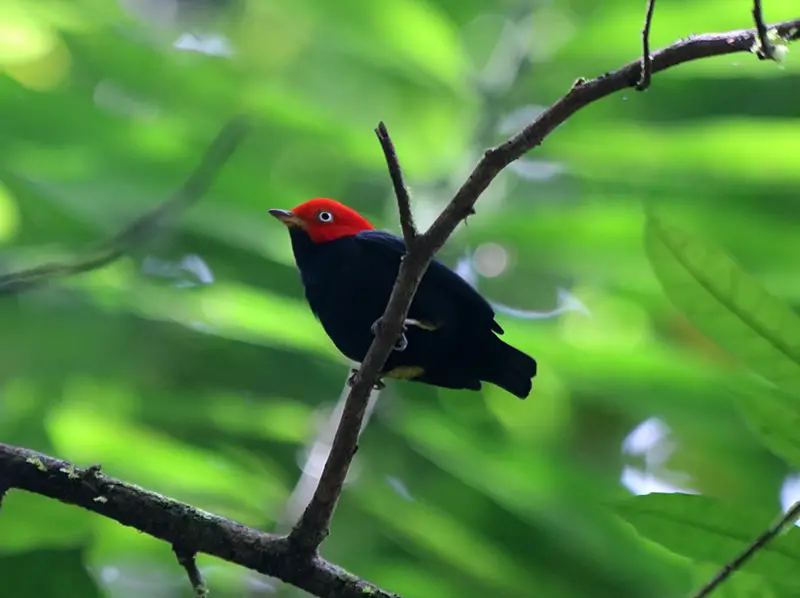
The red-capped manakin is a species of bird found in Central and South America. It has distinctive red feathers on its head that contrast with the otherwise dark plumage, giving it an unmistakable appearance.
The male is particularly noteworthy for his courtship display, which involves rapidly shuffling backwards along a branch while making loud calls to attract potential mates.
This behaviour makes them highly sought after by birdwatchers who come from far and wide to observe this unique ritual.
In addition to their fascinating courtship behavior, they are also important seed dispersers throughout their range which helps maintain healthy ecosystems in these areas.
Despite being relatively common across much of its range, habitat loss due to deforestation has left some populations vulnerable and conservation efforts need continued attention if we want future generations of people have the chance to witness these remarkable birds performing their captivating dance displays.
Scientific classification:
| Kingdom | Animalia |
| Phylum | Chordata |
| Class | Aves |
| Order | Passeriformes |
| Family | Pipridae |
| Genus | Ceratopipra |
| Species | C. mentalis |
39. Ringed Kingfisher
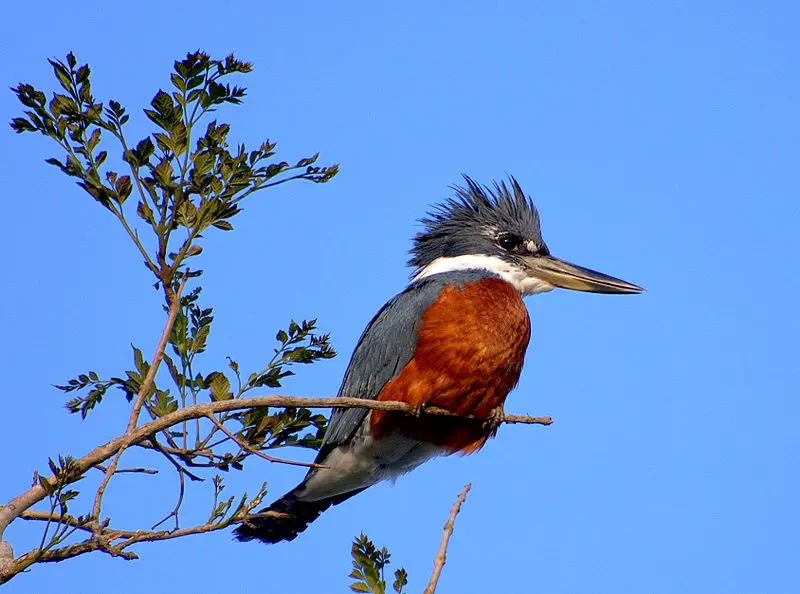
The Ringed Kingfisher is a large, vibrant bird that can be easily noticed by its loud call. It’s found in tropical regions from the lower Rio Grande Valley of southeastern Texas to Central America and even as far south as Tierra del Fuego.
This ground-dwelling species prefers to inhabit open areas near water bodies like streams, rivers and lakes which provide them with plenty of food such as fish, amphibians, crustaceans and insects.
In 1888 it was first identified by ornithologist Frank Chapman who noted its distinct ring pattern on the breast area.
The upperparts are dark blue while underneath they have white spots around their neck and belly region along with pale brown wings tipped in black stripes making this species quite unique among other kingfishers.
They may look intimidating but these birds actually play an important role for humans since they help control insect populations thus helping maintain a healthy balance within our ecosystems.
Scientific classification:
| Kingdom | Animalia |
| Phylum | Chordata |
| Class | Aves |
| Order | Coraciiformes |
| Family | Alcedinidae |
| Subfamily | Cerylinae |
| Genus | Megaceryle |
| Species | M. torquata |
40. Chestnut-Colored Woodpecker
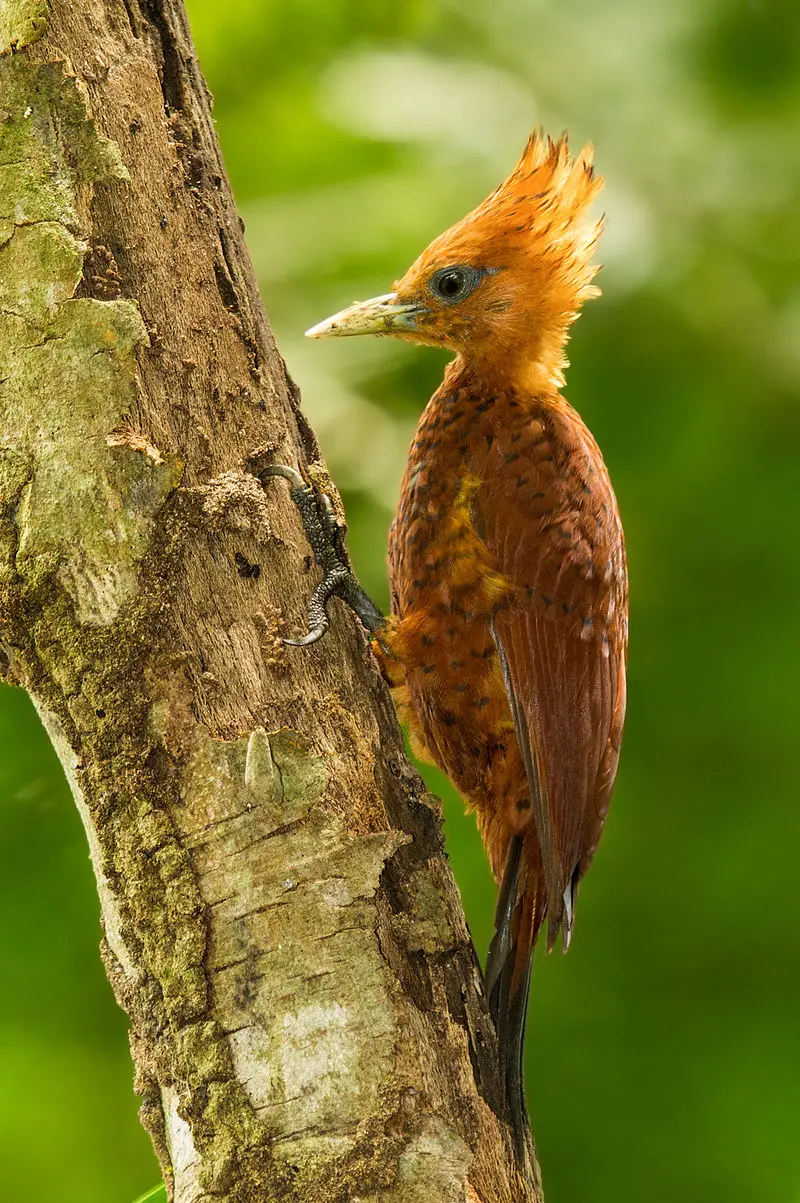
The Chestnut-colored woodpecker is a stunning bird found in Central America. It has an unmistakable rich chestnut color, with intricate V-shaped black markings on its back and wings.
Its head is creamy brown, topped with a crest of feathers and it’s bill has a greenish ivory hue to it. The male also sports broader moustache stripes than the female counterpart, making them easy to tell apart.
This species can be found inhabiting subtropical or tropical moist lowland forests and primarily feeds off insects such as ants, beetles etc., which they capture by drumming rapidly on dead branches or tree trunks using their long bills.
They are very territorial birds but will occasionally flock together when food sources become scarce during dry weather spells .
Scientific classification:
| Kingdom | Animalia |
| Phylum | Chordata |
| Class | Aves |
| Order | Piciformes |
| Family | Picidae |
| Genus | Celeus |
| Species | C. castaneus |
41. Scaled Antpitta

The Scaled antpitta is a species of bird belonging to the family Grallariidae. It can be found in many different countries, including Bolivia, Brazil, Colombia and Venezuela.
Its habitats are typically moist lowland or montane forests– ideal for its small size and peaceful nature. This beautiful creature has grey-brown upperparts with black barring on its wings, while its underparts are whitish with bold chestnut streaks running down them.
The Scaled antpitta feeds mainly on insects which it picks off from leaves or catches mid-air; they have also been known to eat some fruits too.
Despite being quite common within their range, these birds remain incredibly elusive due to their shyness around humans – making spotting one all the more rewarding.
Scientific classification:
| Kingdom | Animalia |
| Phylum | Chordata |
| Class | Aves |
| Order | Passeriformes |
| Family | Grallariidae |
| Genus | Grallaria |
| Species | G. guatimalensis |
42. Brown Violetear
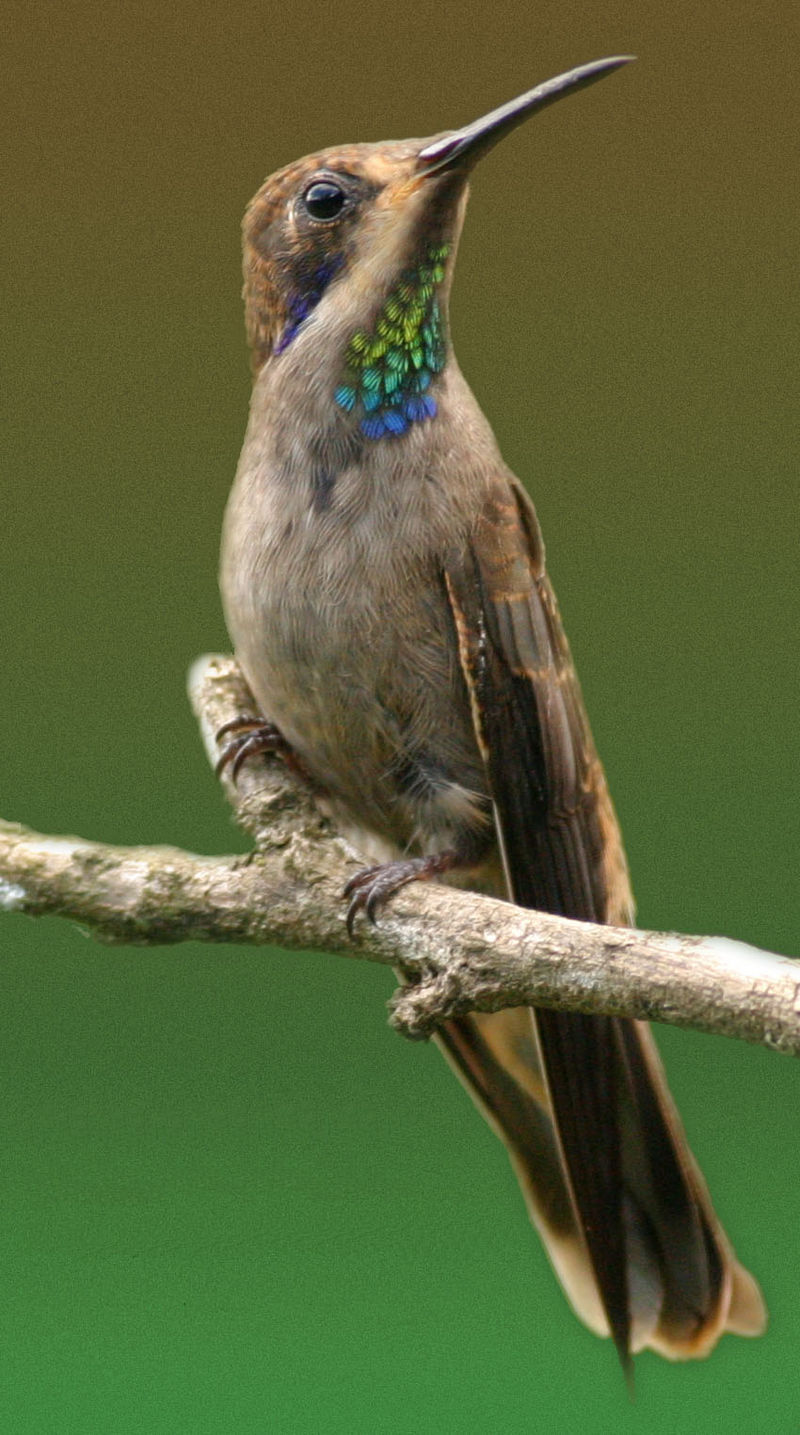
The Brown Violetear is a spectacular hummingbird, renowned for its beautiful plumage and wingspan of up to 4 inches. It can be found in Central America, the Andes region and northern South America including Trinidad and Brazil’s Bahia state.
Favoring middle elevations between 400-1600m, this species nests in forests characterized by lush vegetation.
During mating season males are adorned with conspicuous violet feathers on their ears which give them their name ‘Violetear’. The birds feed mainly from nectar rich flowers like lantana camara or banana trees.
Their diet also consists of small insects such as fruit flies that provide necessary proteins for energy needs during flight.
With a lifespan of around 5 years these amazing creatures bring joy to many birdwatchers who travel far just to catch sight of them.
Scientific classification:
| Kingdom | Animalia |
| Phylum | Chordata |
| Class | Aves |
| Order | Apodiformes |
| Family | Trochilidae |
| Genus | Colibri |
| Species | C. delphinae |
43. Black-Cheeked Woodpecker
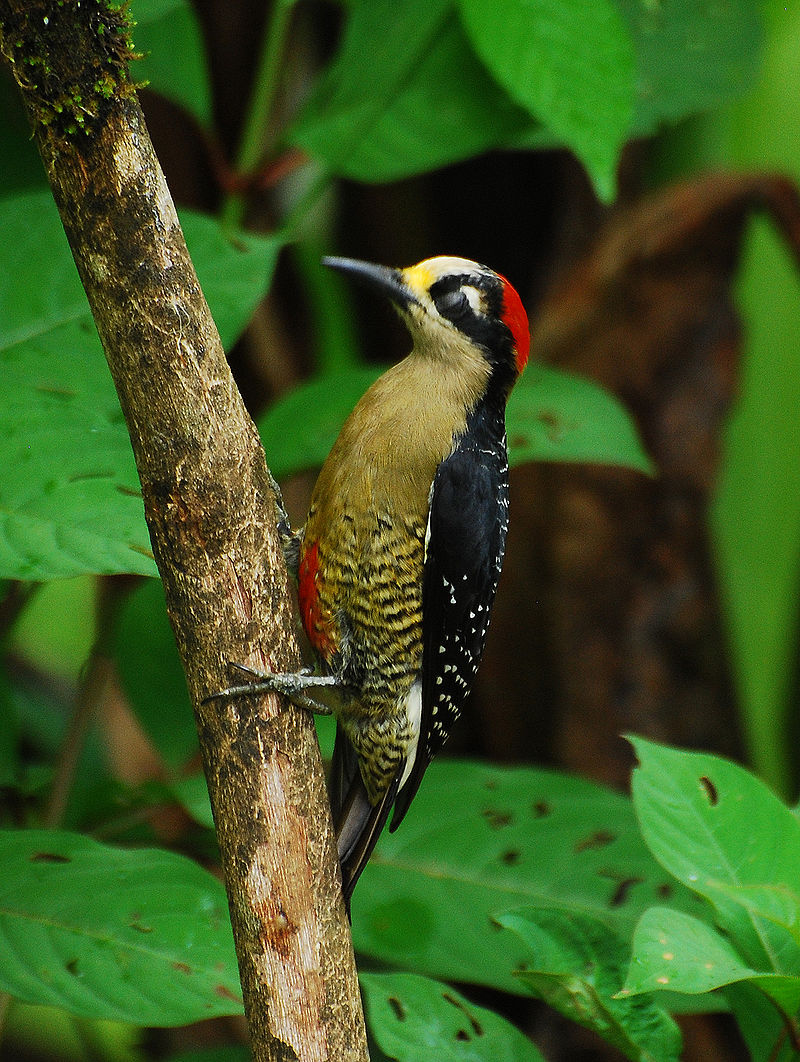
The Black-cheeked Woodpecker is a medium sized, colorful bird found in tropical regions of Mexico, Central America and Ecuador.
The species has black upperparts with patches of yellow and red on the wings as well as white underparts contrasted by its namesake black cheeks.
These birds are often seen foraging alone or in pairs through their preferred habitats: wet forests, semi-open woodlands and old secondary growths.
They nest high up in dead trees where they lay two to four glossy white eggs that both sexes incubate together until hatching time arrives.
This species bears the Latin name Melanerpes pucherani which commemorates an Italian naturalist who first described it over 200 years ago. A beautiful specimen of nature’s creations.
Scientific classification:
| Kingdom | Animalia |
| Phylum | Chordata |
| Class | Aves |
| Order | Piciformes |
| Family | Picidae |
| Genus | Melanerpes |
| Species | M. pucherani |
44. Great-Tailed Grackle
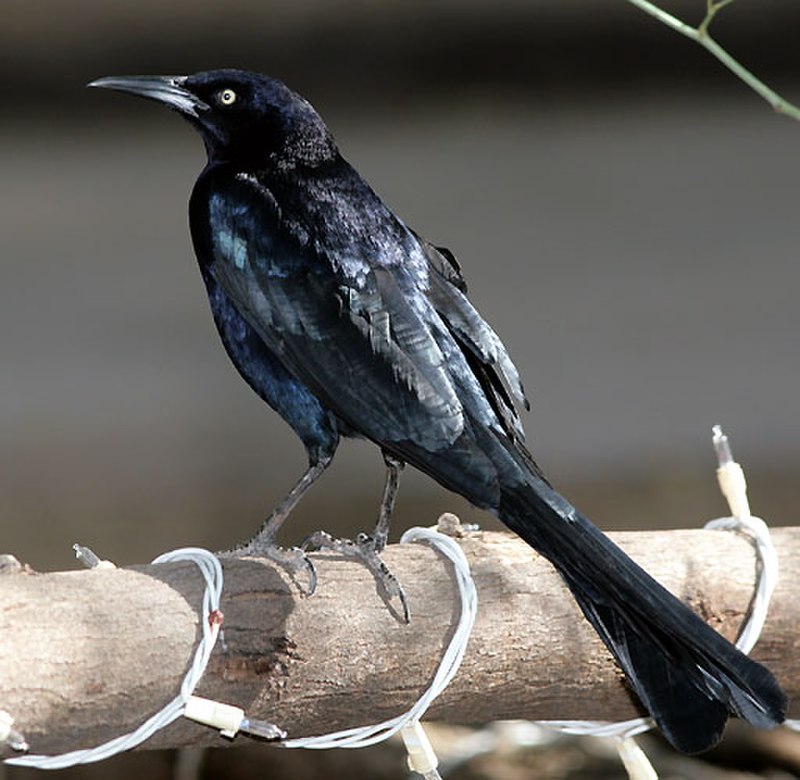
The Great-tailed Grackle is a medium sized bird native to North and South America. It belongs to the family Icteridae, making it closely related to two other species of grackles – the Boat-tailed and Slender-billed.
They are highly social birds which often appear in large flocks or colonies.
Their plumage ranges from glossy black with blue or purple iridescence, through brownish grey shades depending on location.
In some areas they have been known as “blackbirds” due their predominately dark colouring.
This adaptable species is also renowned for its distinctive long tail feathers – hence its name.
Scientific classification:
| Kingdom | Animalia |
| Phylum | Chordata |
| Class | Aves |
| Order | Passeriformes |
| Family | Icteridae |
| Genus | Quiscalus |
| Species | Q. mexicanus |
45. Little Tinamou
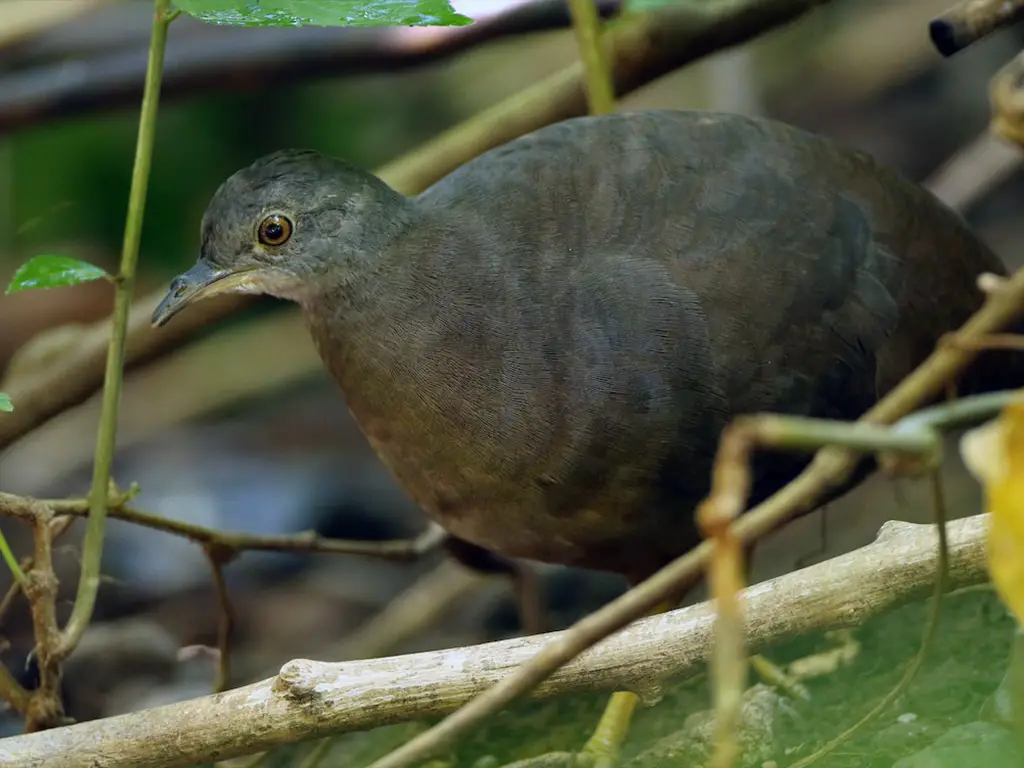
The Little Tinamou (Crypturellus soui) is a species of bird native to Central and South America, as well as the Caribbean island of Trinidad. Its name comes from its Latin or Greek root words; kruptos meaning “covered” or “hidden”, oura meaning “tail,” and ellus meaning “diminutive” – Crypturellus means small hidden tail.
The little tinamou has an overall dark brown colouration with speckles on its wings, neck, back and breast. It measures 27–29 cm in length when fully grown and weighs about 170g.
Its diet consists mainly of fruit but also includes various insects, lizards & frogs which it forages for amongst leaf litter on the forest floor during dawn till dusk every day.
Despite being listed as Least Concern by IUCN due to their wide range across many countries they are still vulnerable to deforestation caused by human activity.
Scientific classification:
| Kingdom | Animalia |
| Phylum | Chordata |
| Class | Aves |
| Infraclass | Palaeognathae |
| Order | Tinamiformes |
| Family | Tinamidae |
| Genus | Crypturellus |
| Species | C. soui |
46. King Vulture
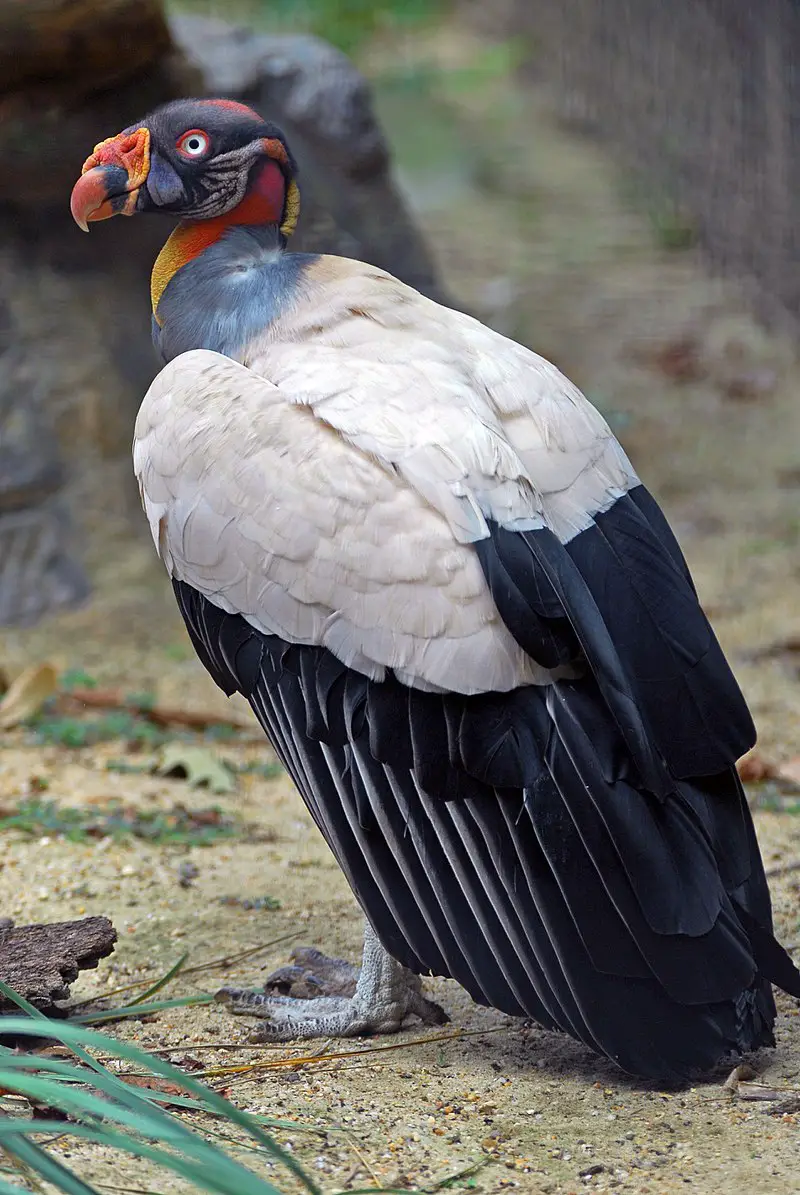
The King Vulture is a majestic bird found in Central and South America. It has striking white plumage with black accents, and its head is topped by a bright yellow crest.
With long wingspan of up to 4 feet, this vulture soars gracefully through the sky. Its large size allows it to dominate other scavenging birds at carcasses; although not as powerful as some raptors, the king vulture will protect what belongs to it fiercely.
The diet of these elegant creatures consists mainly of carrion such as dead mammals or fish that they spot from far away using their excellent vision.
They also occasionally eat eggs or nestlings if food is scarce during dry seasons.
This fascinating species plays an important role in keeping ecosystems healthy by removing dead animals from landscapes quickly before diseases spread further into populations.
Scientific classification:
| Kingdom | Animalia |
| Phylum | Chordata |
| Class | Aves |
| Order | Accipitriformes |
| Family | Cathartidae |
| Genus | Sarcoramphus |
| Species | S. papa |
47. Azure-Hooded Jay
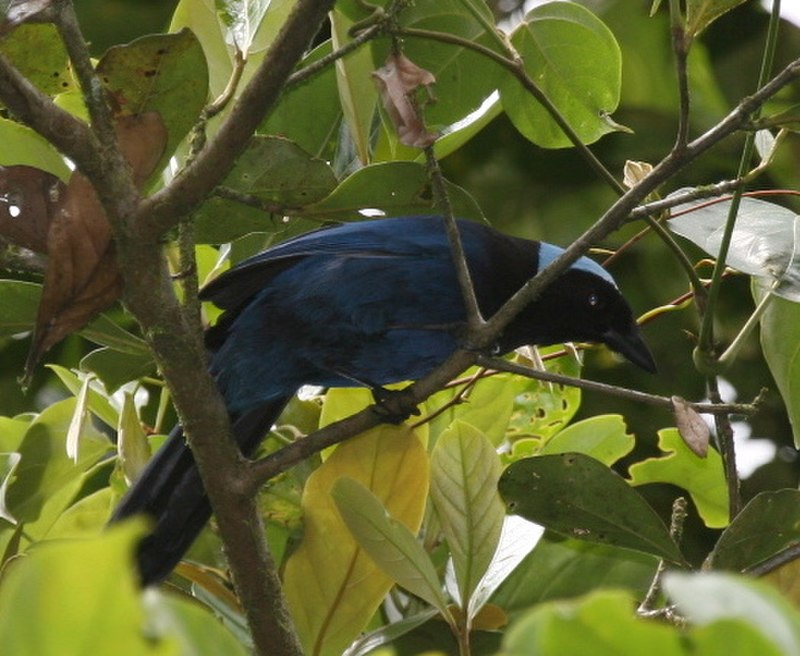
The Azure-hooded Jay is a beautiful bird found in Middle America. It has an impressive length of 11 to 12 inches and its plumage consists of dark blue feathers with a black head, upper chest and sky blue back of the neck and head, with a white border.
This species belongs to the Corvidae family and it has four known subspecies.
The jay prefers subtropical or tropical moist montane forests as its natural habitat where it can find food easily such as fruits, insects, lizards and small birds eggs which are part of their diet.
Its majestic colors make this species stand out from other birds making them quite attractive for birdwatchers who enjoy observing these amazing creatures in their own environment.
Scientific classification:
| Kingdom | Animalia |
| Phylum | Chordata |
| Class | Aves |
| Order | Passeriformes |
| Family | Corvidae |
| Genus | Cyanolyca |
| Species | C. cucullata |
48. Ruddy Crake
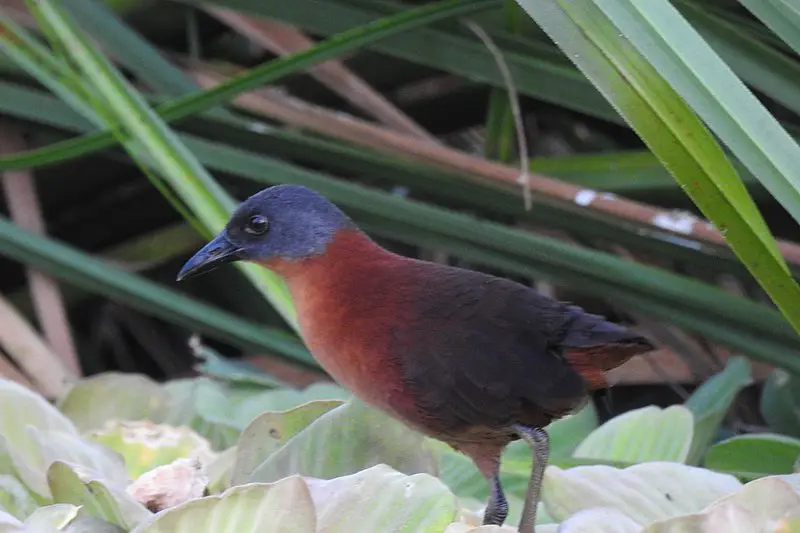
The Ruddy Crake is a beautifully vibrant bird that belongs to the Rail family. It has reddish-brown plumage, which can vary in shade and have a grey head with dark brown wings and tail.
Its crown is blackish while its ear coverts are light grey. The chin and belly of the bird are paler than other parts of it’s body.
This species doesn’t migrate but instead lives in wetland areas throughout South America including Argentina, Bolivia Brazil, Colombia, Ecuador Paraguay Peru Uruguay & Venezuela.
They feed on small invertebrates such as insects or crustaceans found near water sources like marshes or ponds making them very similar to their rail relatives who also inhabit these types of habitats.
All in all this beautiful red creature makes for an interesting sight when encountered out in nature.
Scientific classification:
| Kingdom | Animalia |
| Phylum | Chordata |
| Class | Aves |
| Order | Gruiformes |
| Family | Rallidae |
| Genus | Laterallus |
| Species | L. ruber |
49. Rufous Motmot
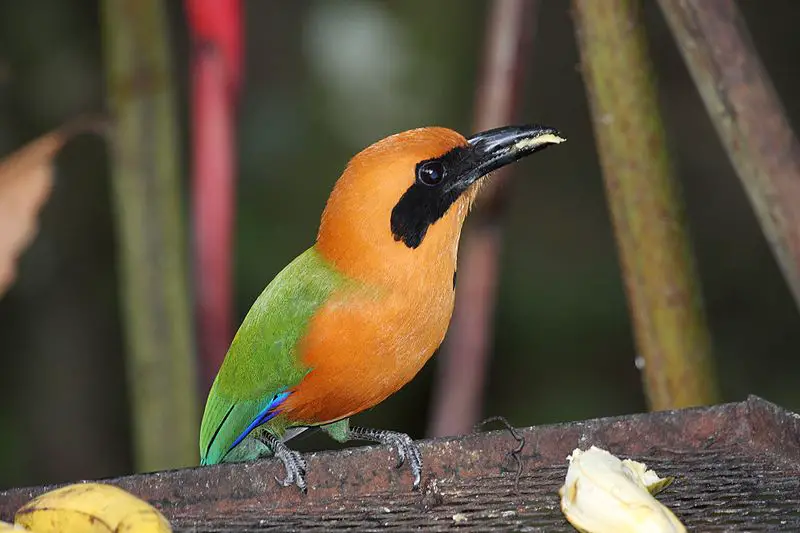
The Rufous Motmot is a beautiful bird found across Central and South America. It belongs to the Momotidae family, along with its close relative, the rufous-capped motmot.
This colorful species has dark blue wings and tail feathers, brownish body plumage, a bright orange breast patch and white tips on its long middle tail feathers. Its distinctive call sounds like ‘who who’ or ‘hoot hoot.’
These birds are monogamous during breeding season but can also be seen in groups of up to ten individuals foraging together for food such as insects, scorpions and small lizards.
They build their nests near streams in tunnels they excavate themselves using their robust bills full of bristles which gives them an impressive appearance when they emerge from inside these underground chambers.
Scientific classification:
| Kingdom | Animalia |
| Phylum | Chordata |
| Class | Aves |
| Order | Coraciiformes |
| Family | Momotidae |
| Genus | Baryphthengus |
| Species | B. martii |
50. Violet Sabrewing
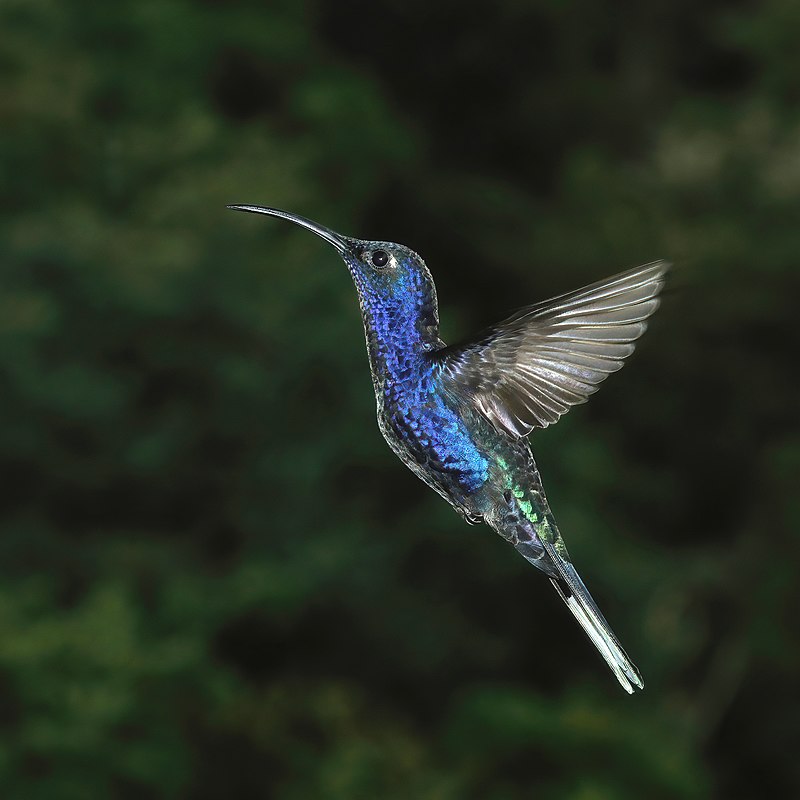
The Violet Sabrewing is the largest hummingbird in Mexico and Central America, with a length of 13-15cm (5.1 to 5.9in).
It belongs to the Trochilini tribe of Emeralds subfamily (Trochilinae), and has two distinct species – C. h. hemileucurus and C. h.. mellitus – found from Mexico to Panama.
This colorful bird typically sports an iridescent violet throat, shining green back, white breast as well as black head, tail feathers and beak tip; all adding up to its stunning beauty.
Its diet consists mainly nectar it collects from flowers by hovering around them like typical hummingbirds do but also feeds on small insects for much needed protein intake.
The Violet Sabrewing is known for their long migrations across great distances just so they can find suitable places where food sources are abundant during different seasons throughout the year.
Scientific classification:
| Kingdom | Animalia |
| Phylum | Chordata |
| Class | Aves |
| Order | Apodiformes |
| Family | Trochilidae |
| Genus | Campylopterus |
| Species | C. hemileucurus |